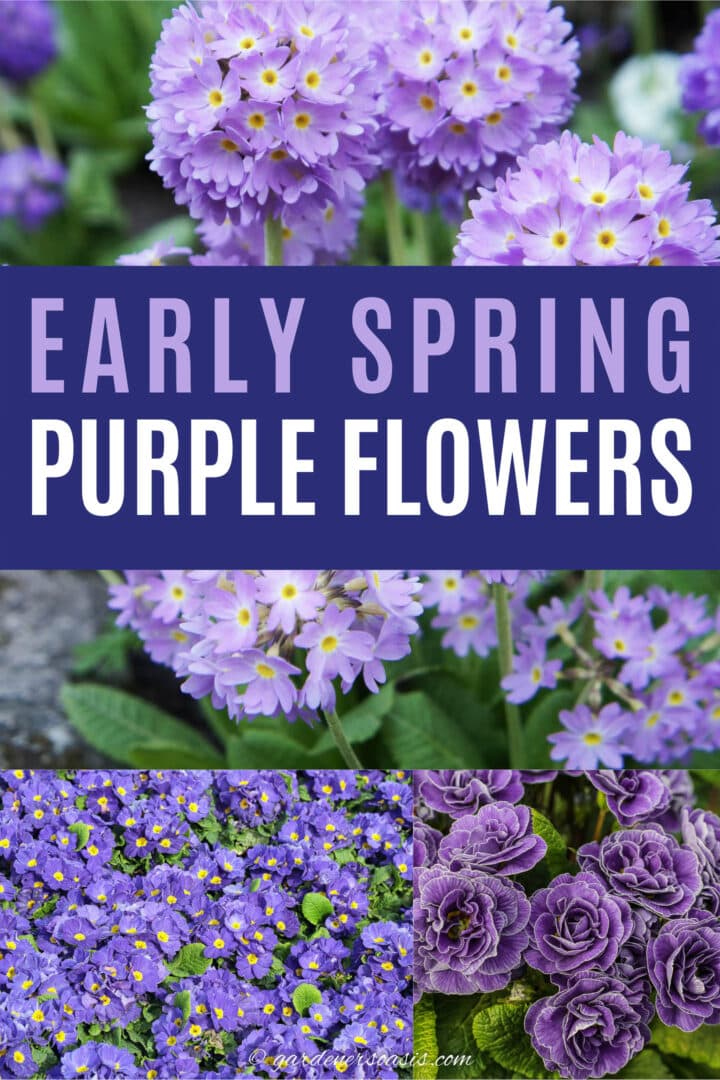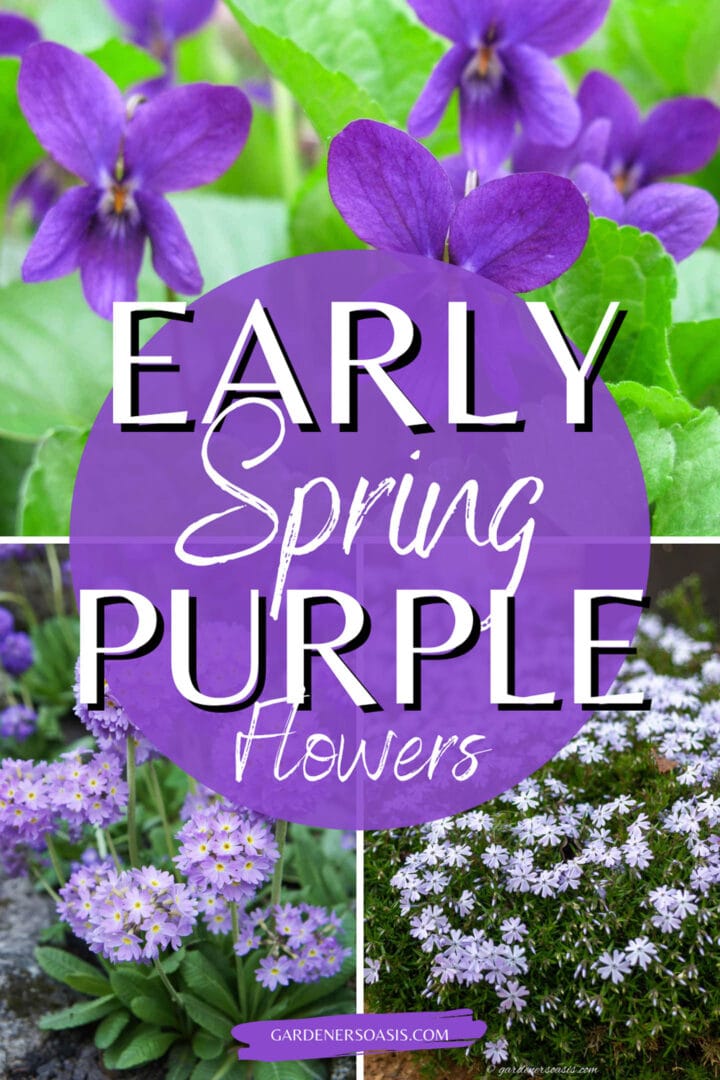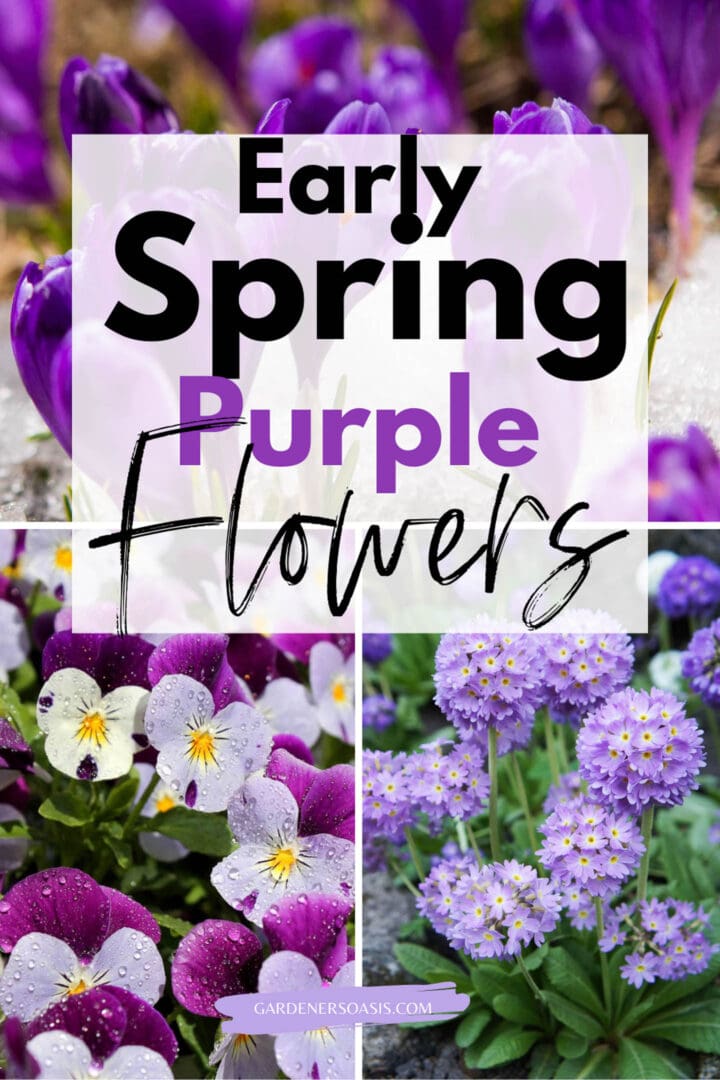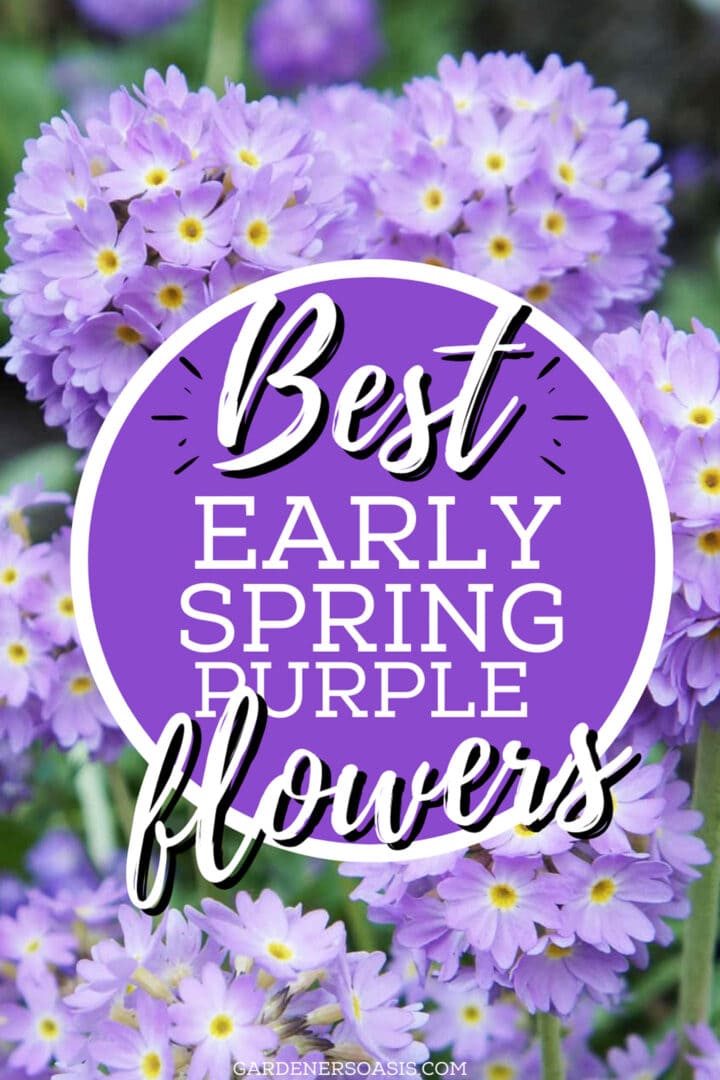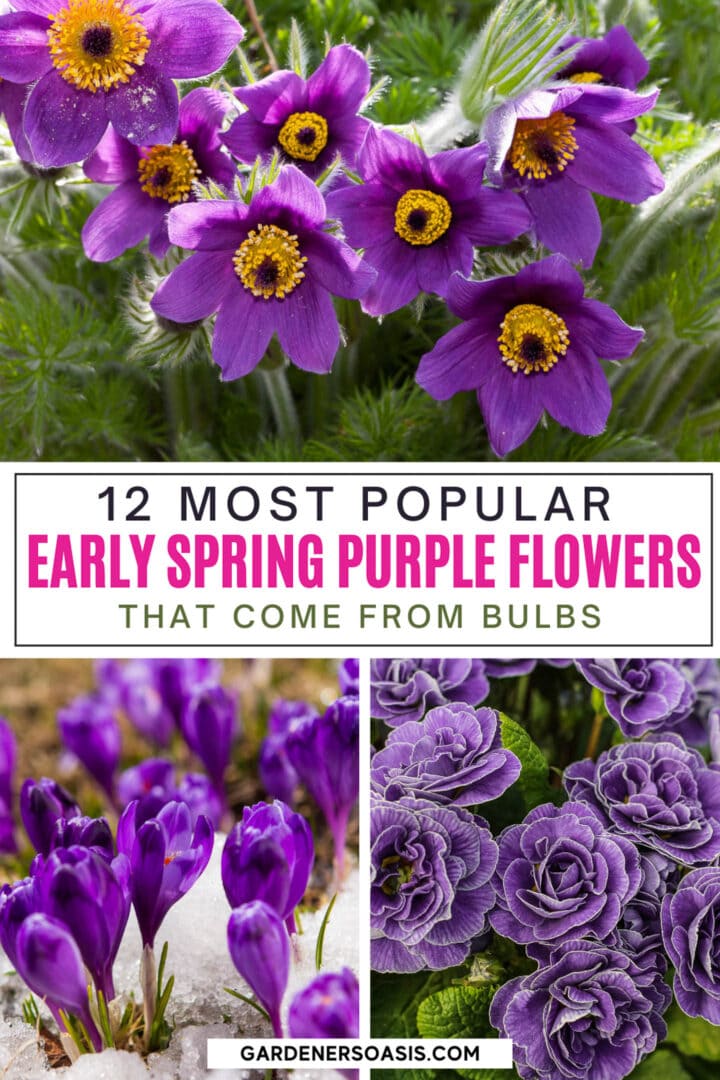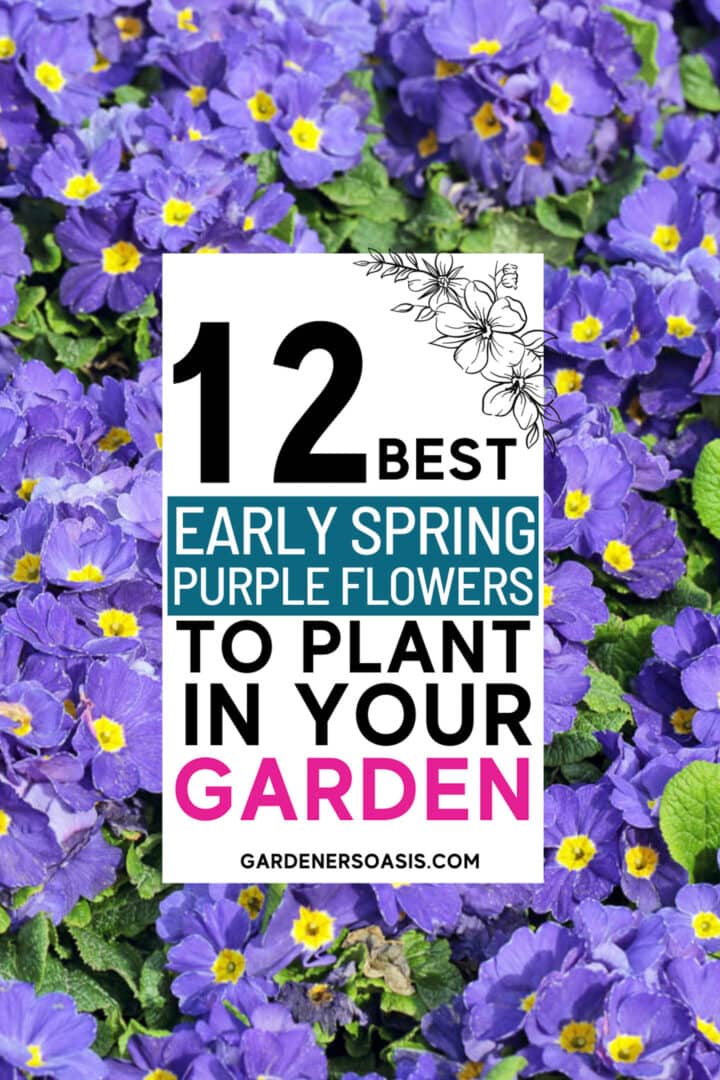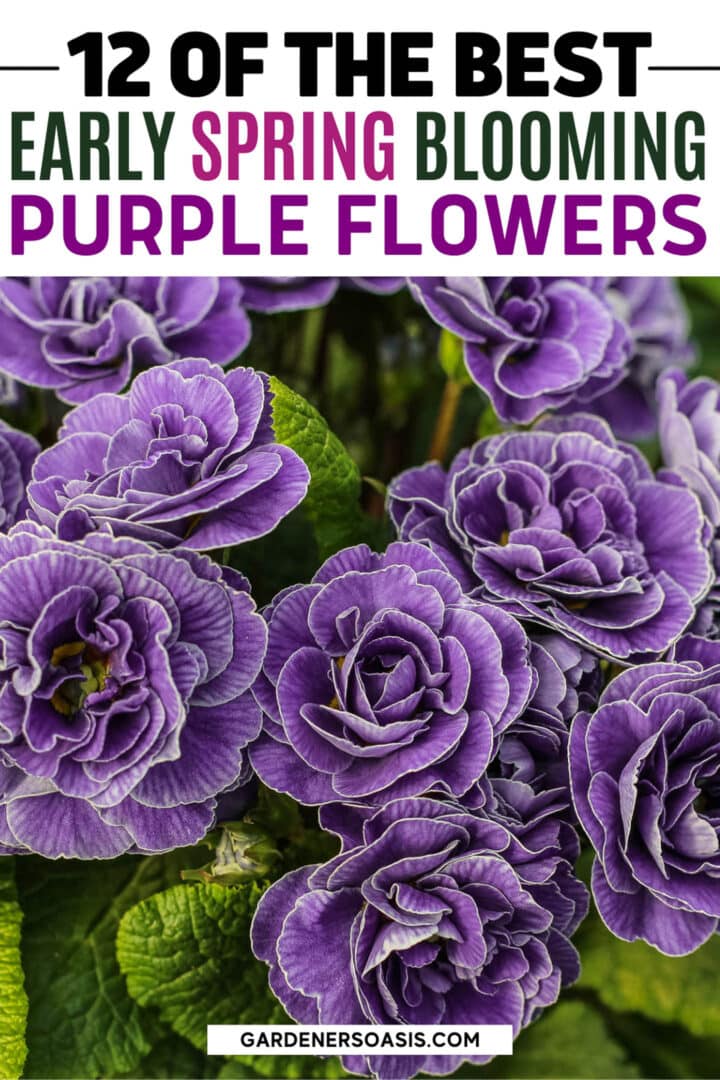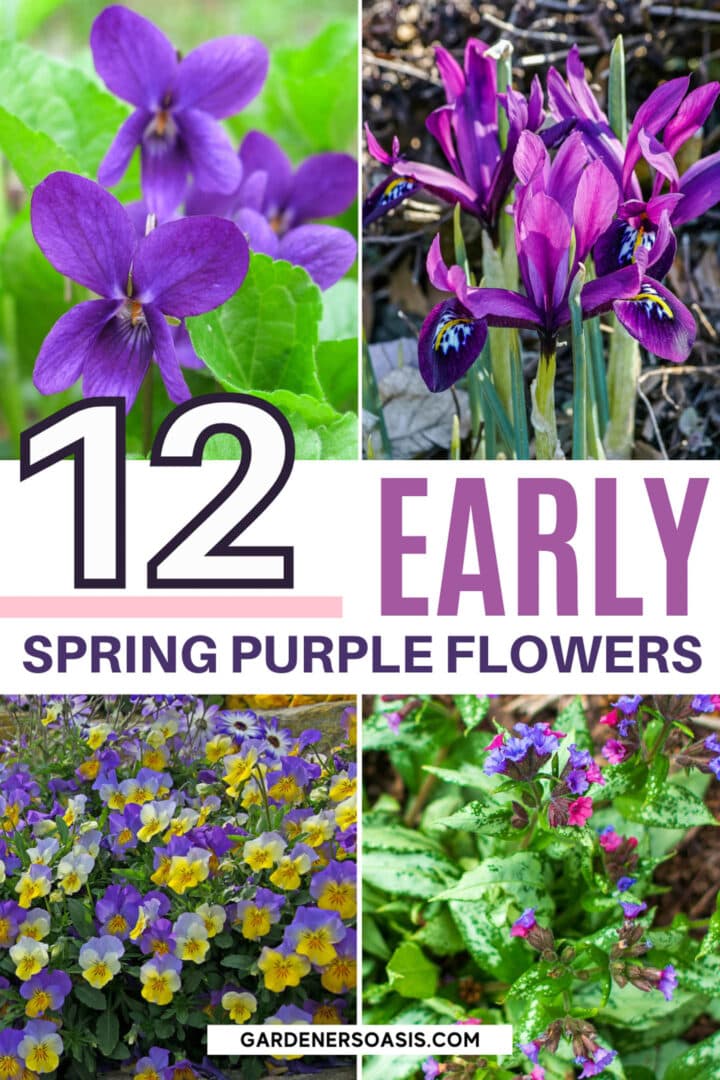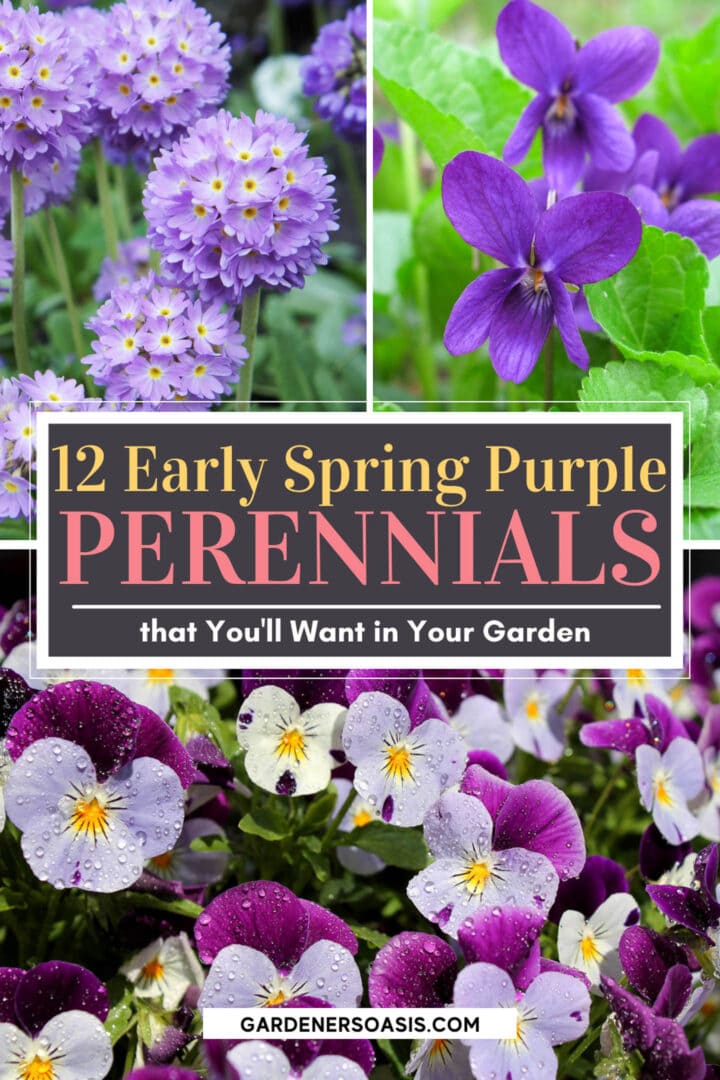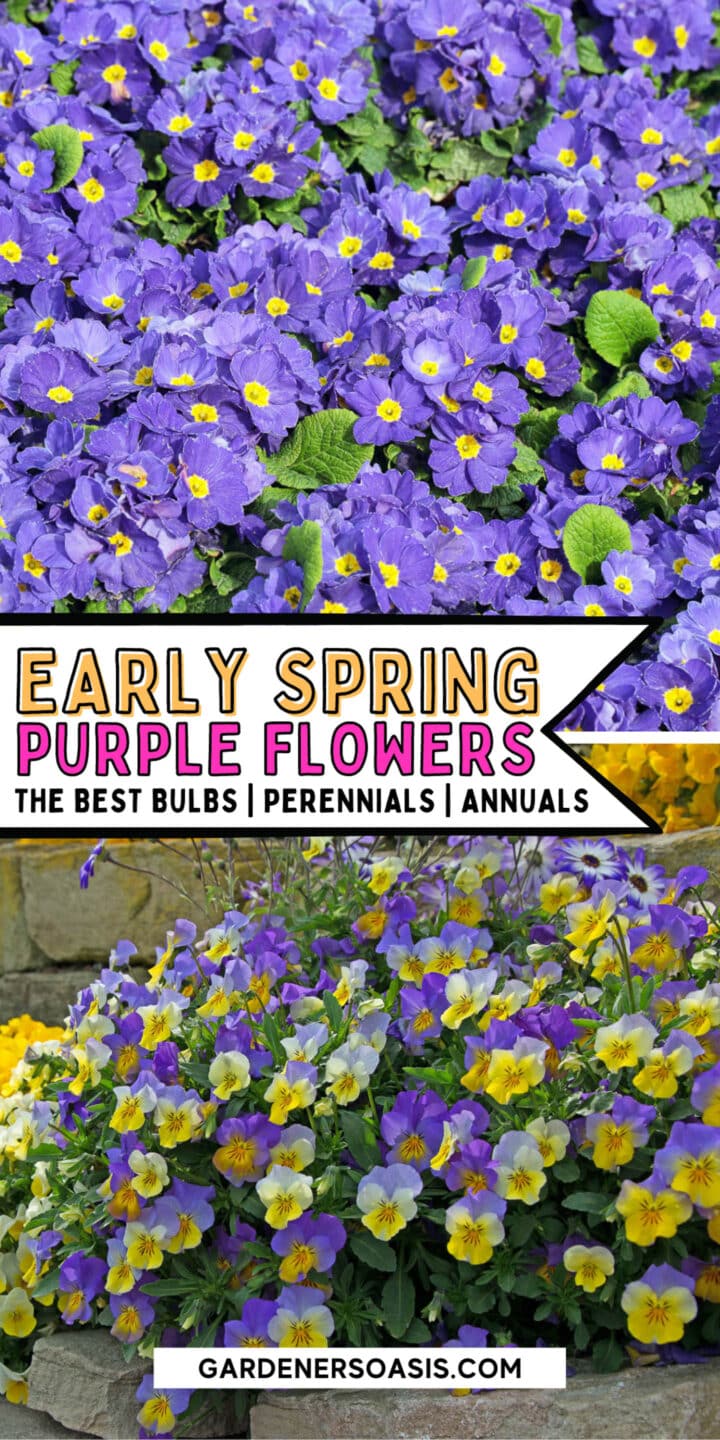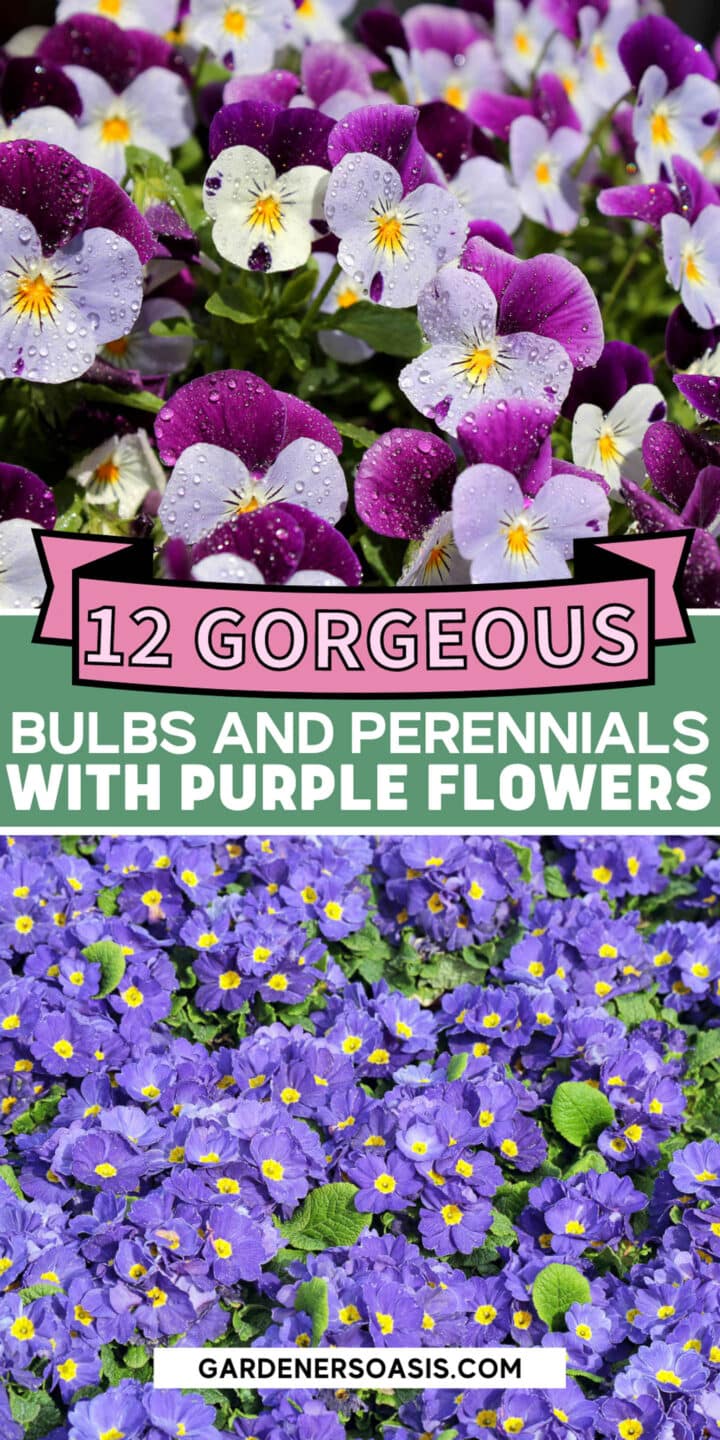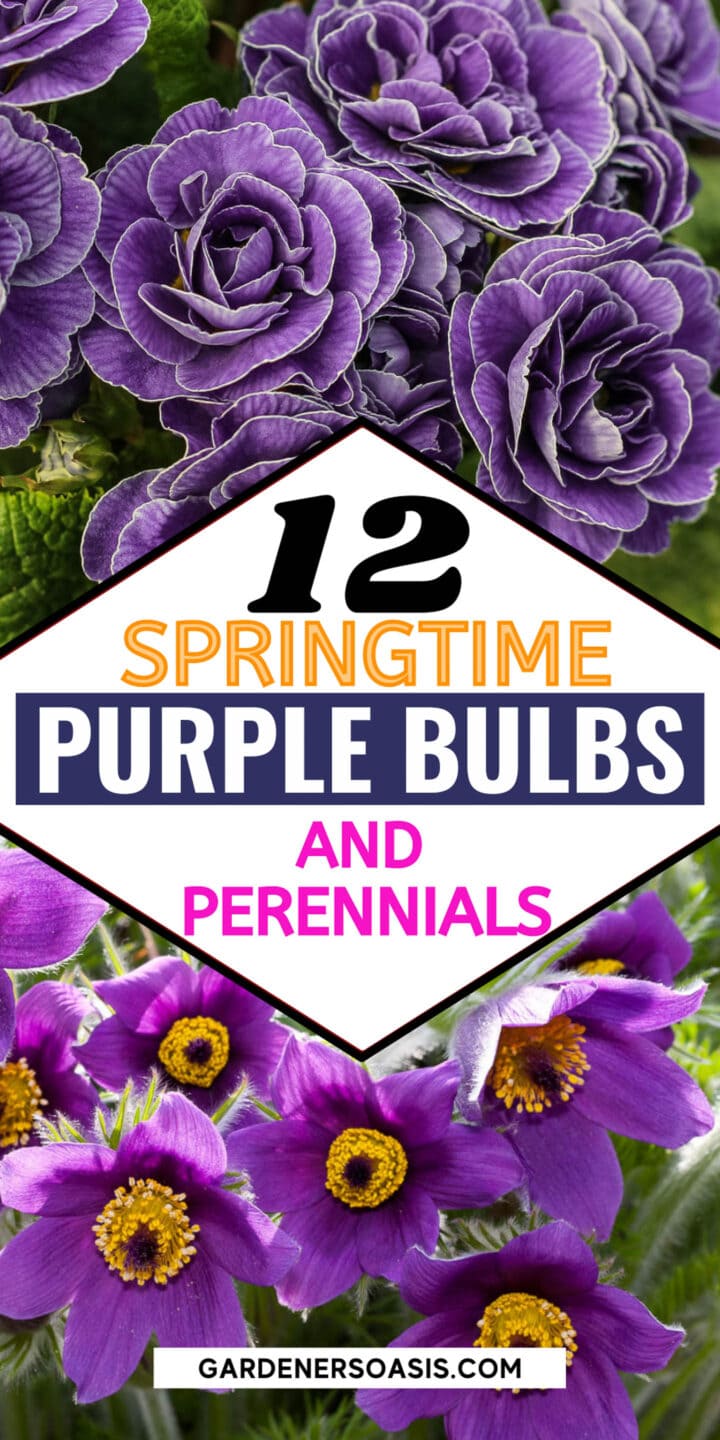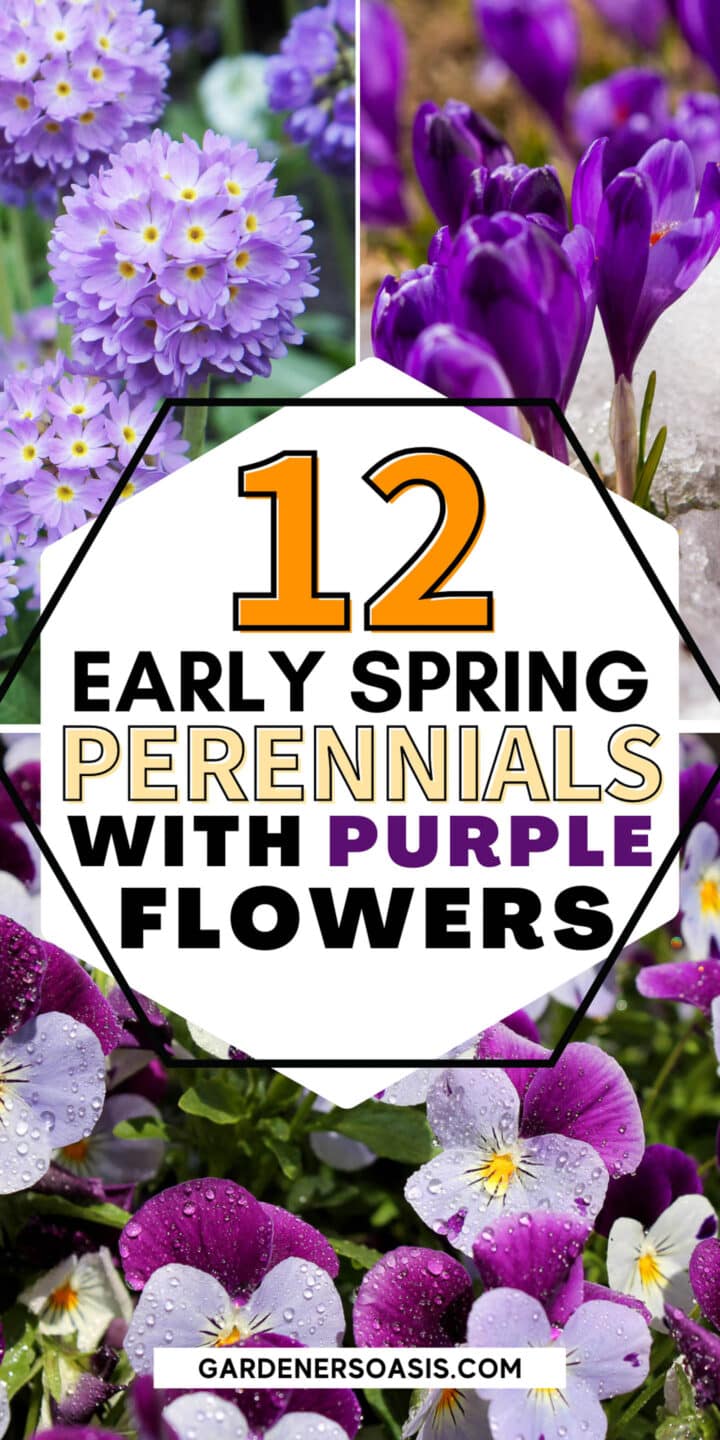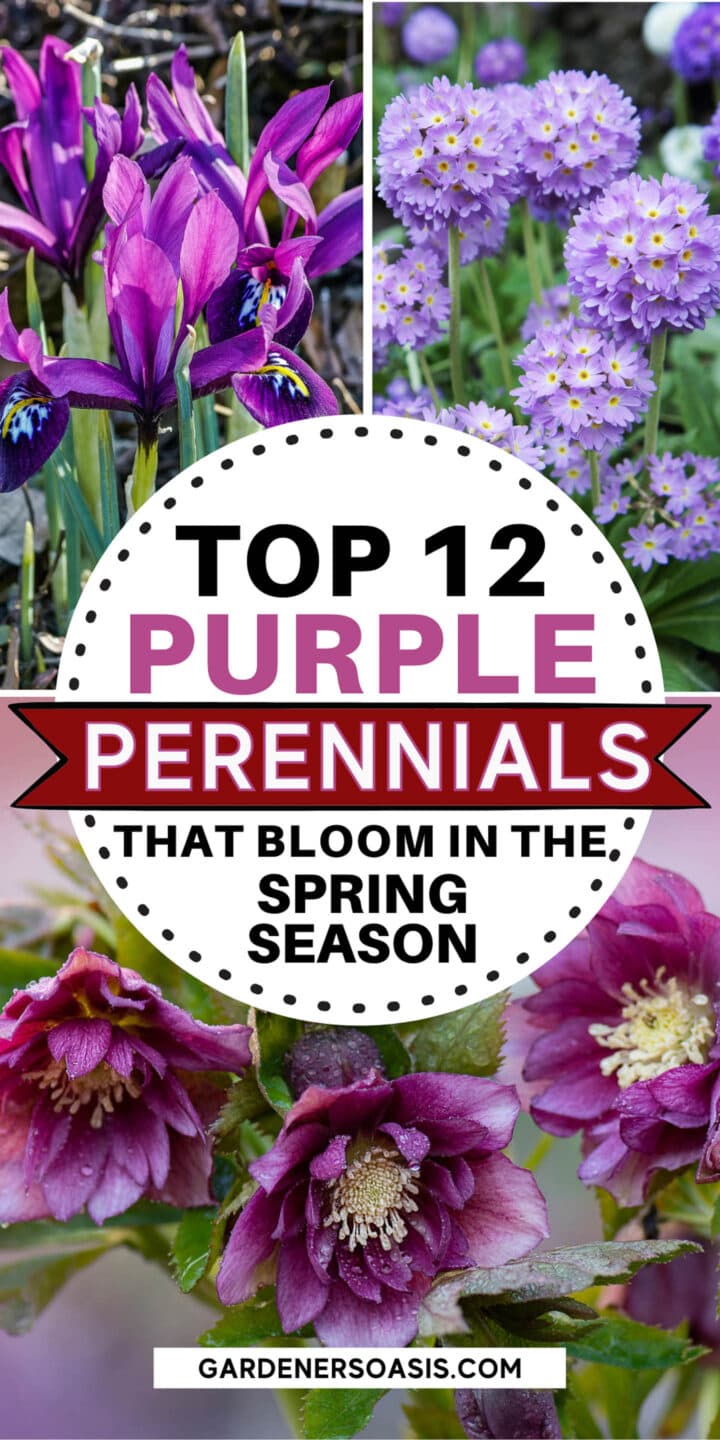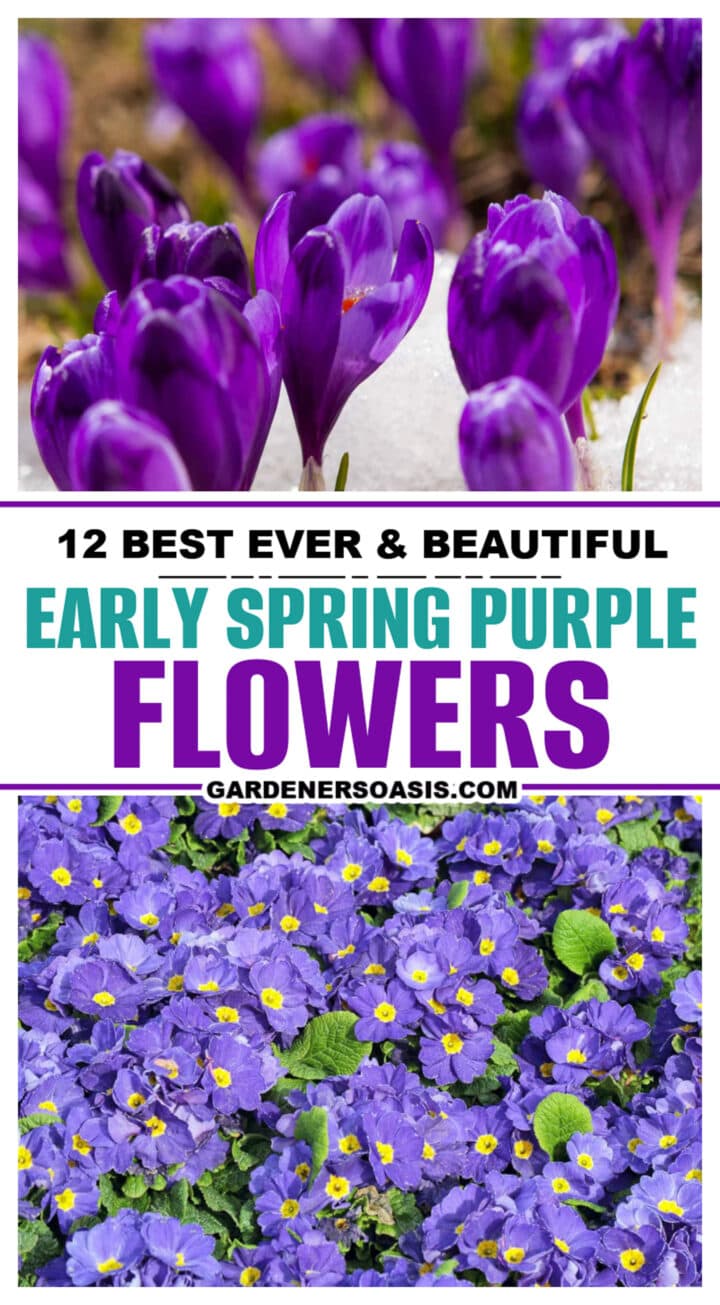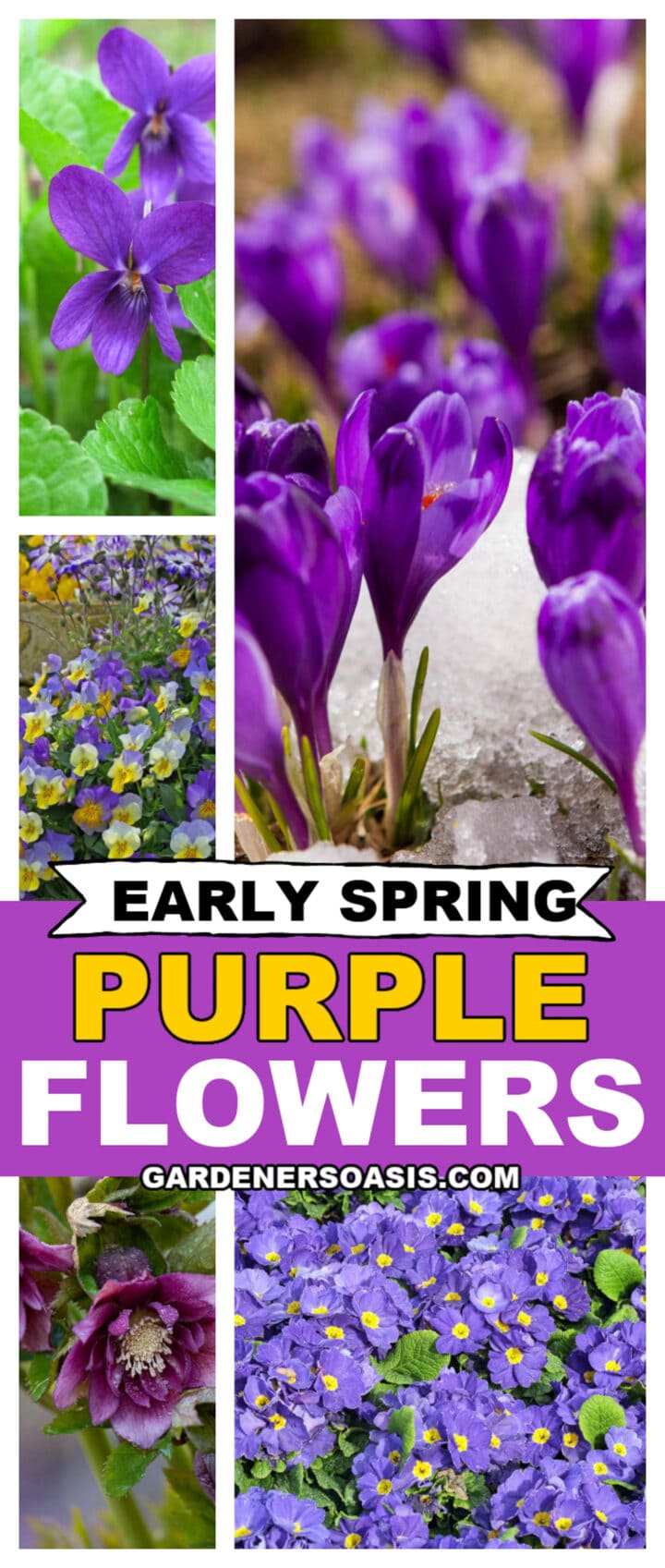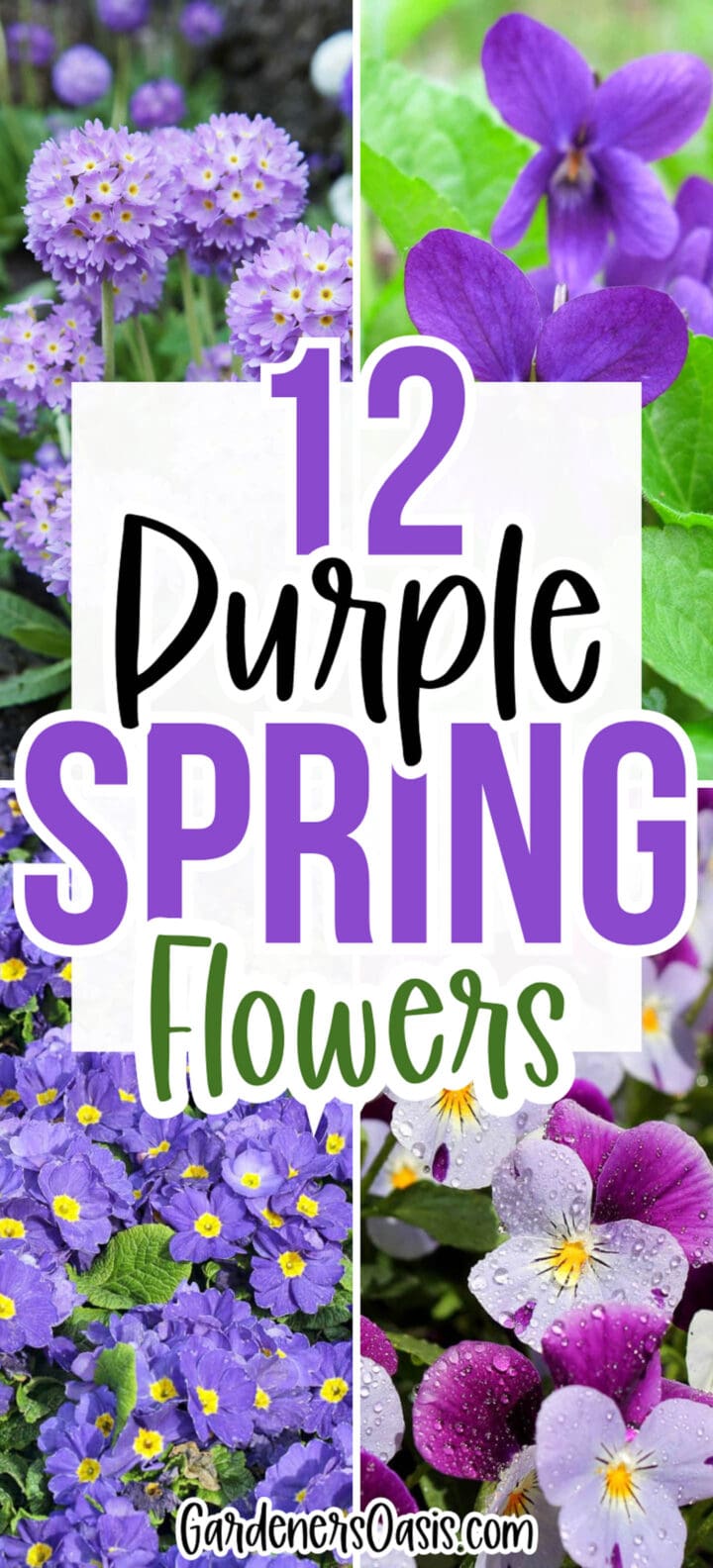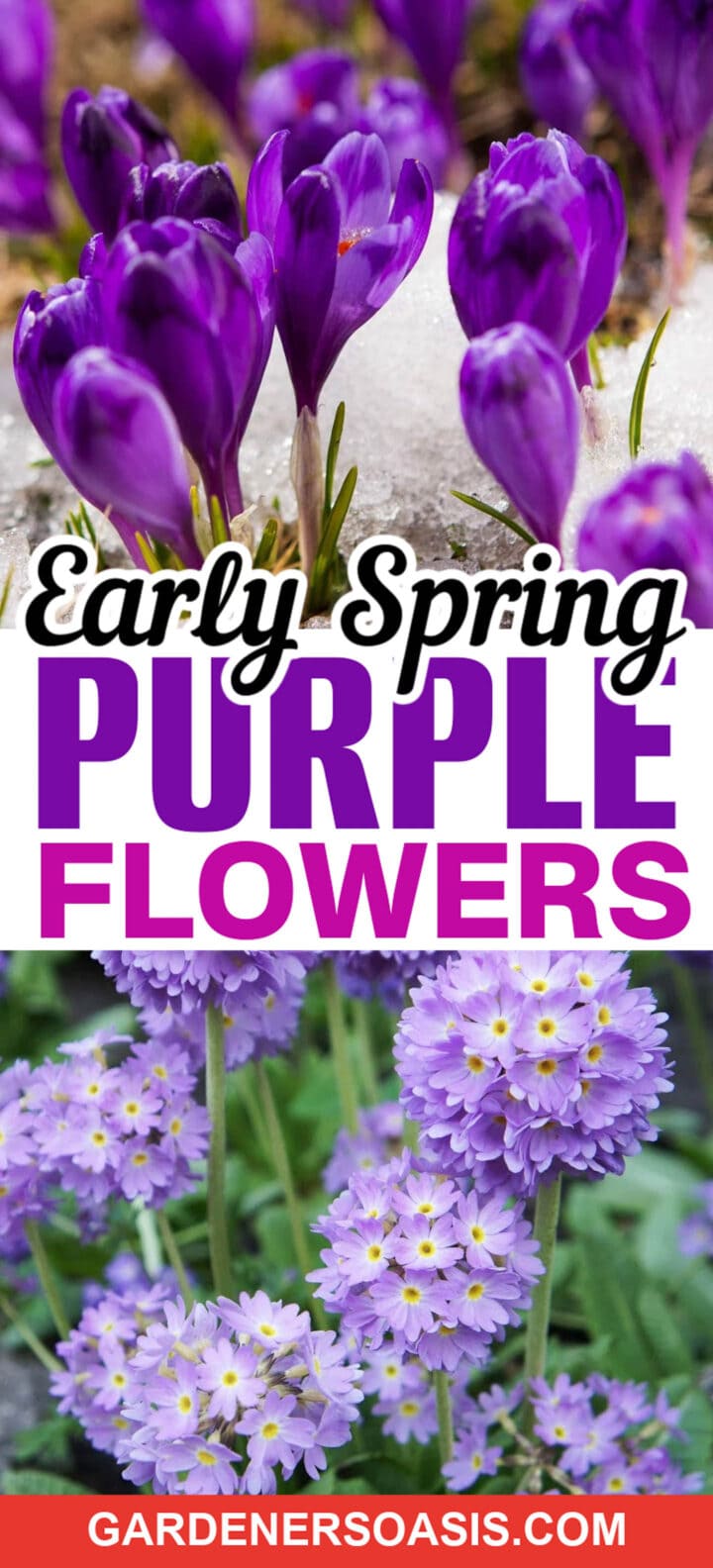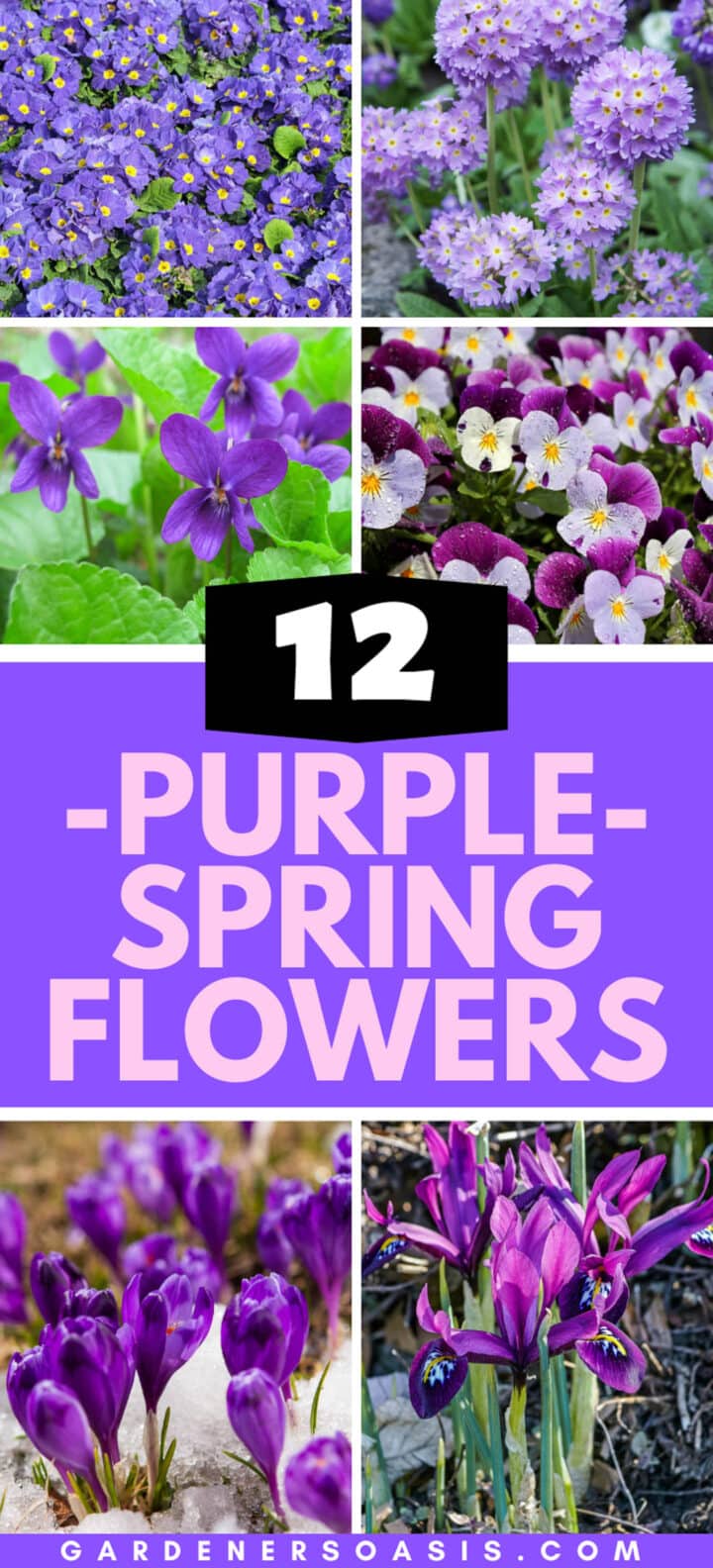Early Spring Purple Flowers (The Best Bulbs, Perennials & Annuals)
Is your garden looking a little drab after a long winter? (Mine certainly is). If you want to add a little color and elegance to your landscape, these early spring purple flowers may be just what you're looking for.
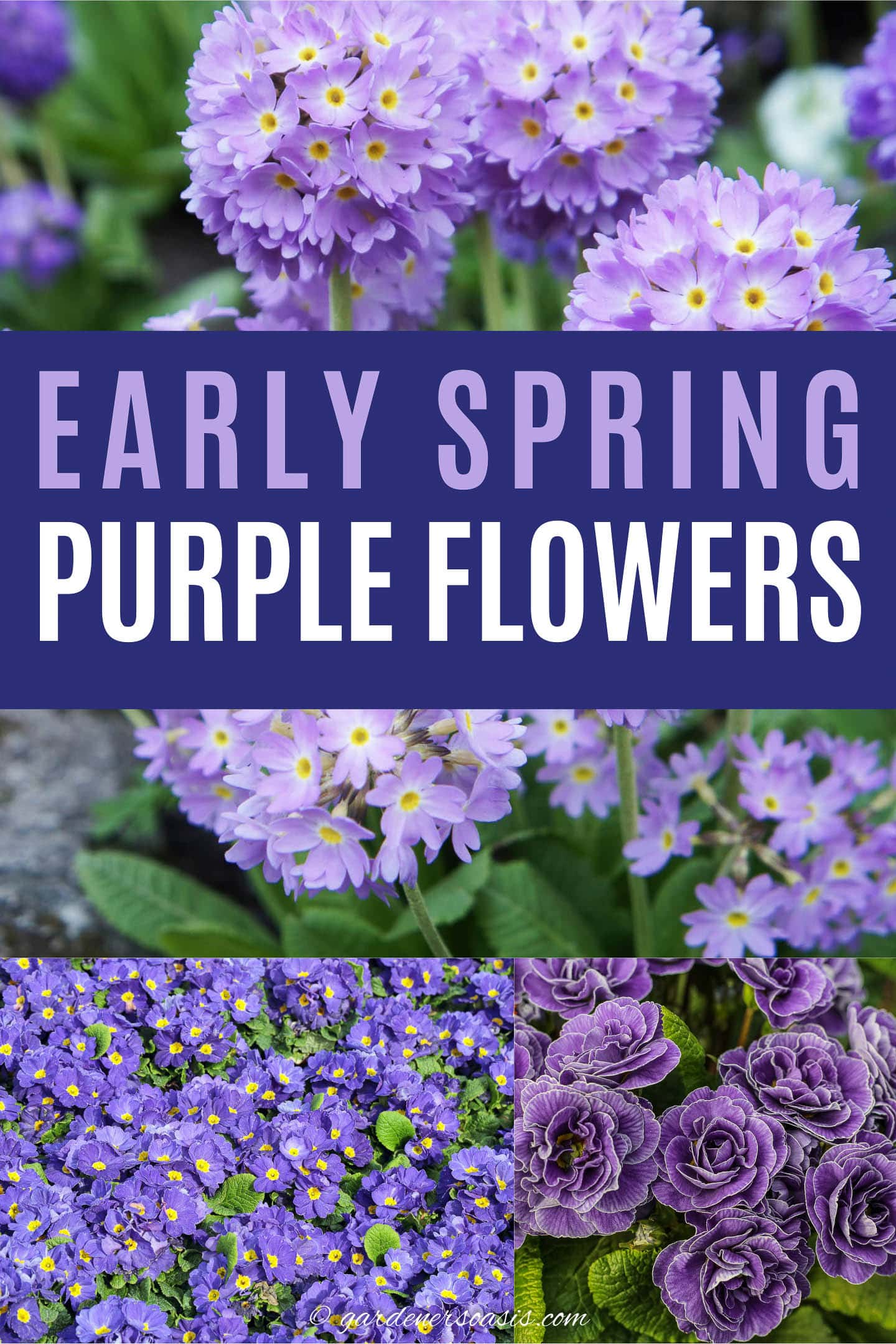
Are you desperate for some color in your garden after a long winter?
If so, you're in luck!
There are plenty of early spring flowers that will add a splash of color to your landscape.
And these purple ones are some of my favorites! They are the perfect color complement for the easy-to-find yellows and whites of other spring bloomers.
From bulbs (like crocuses and irises) to perennials (like primula and violas) and even a couple of annuals, there are many different options to choose from.
So if you love purple as much as I do, this list of purple spring flowers is for you!
1 | Crocus
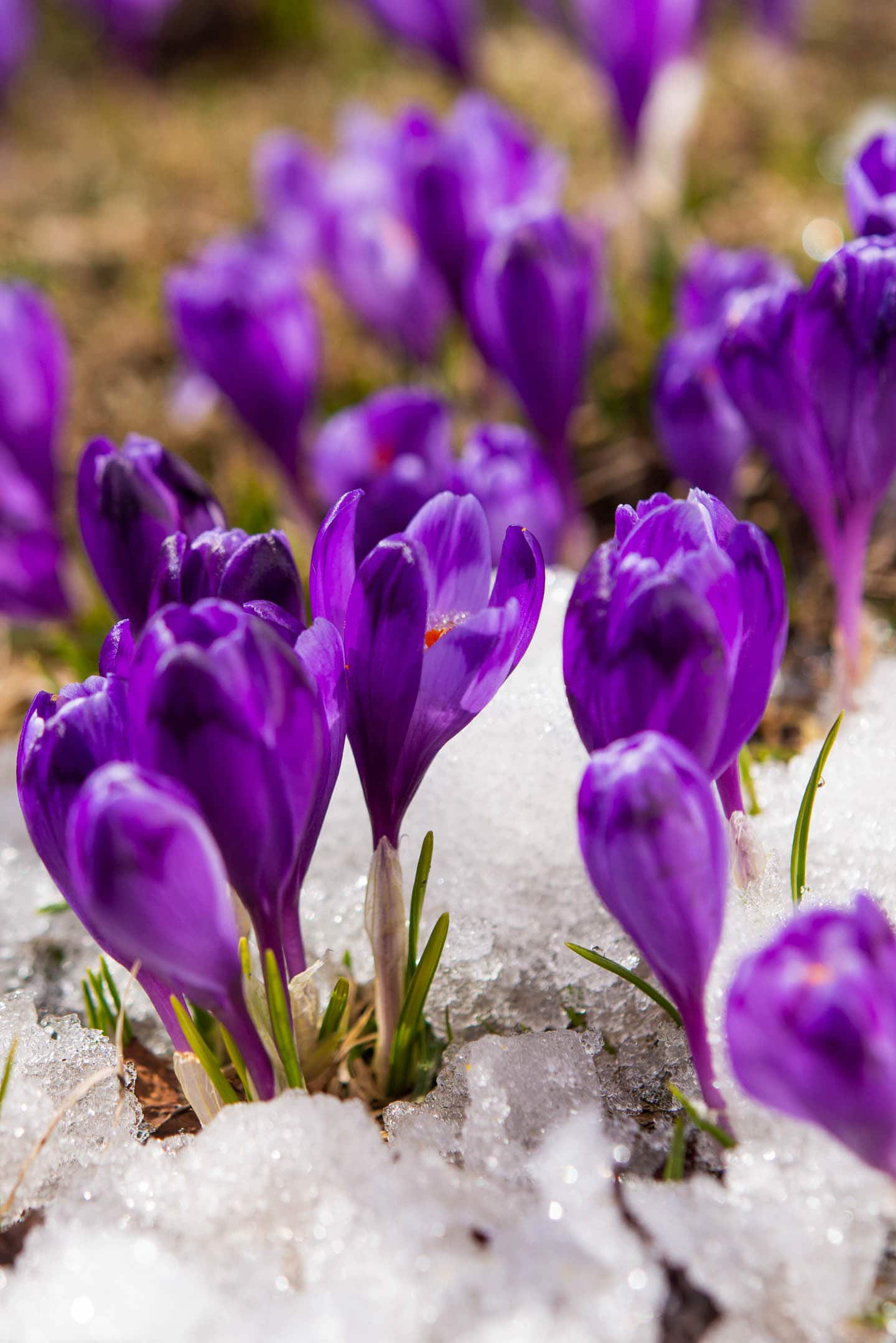
Zone: 3 to 8
Exposure: sun, part sun
Height: 2″ to 4″
Width: 2′ to 4″
Bloom time: late winter, early spring
Bloom color: purple, blue, orange, pink, white, yellow
Some of the most popular early spring purple flowers come from bulbs.
While they bloom in the spring, these bulbs should be planted in the fall. So you'll need to add them to your list for ordering later in the season.
Crocus are one of the earliest blooms to break through the snow crust in late winter.
And many of them are a delightful purple hue with enough fragrance to lure bees out of hibernation.
Crocus corms should be planted in well-drained soil 3 to 4 inches deep, in bunches of 10 or more.
Avoid sowing them in straight rows for a more natural look. Water well and cover with mulch.
Unfortunately, both deer and squirrels like the crocus bulbs and plants.
If squirrels are a problem, you can try placing the corms in wire cages underground or covering the bulb bed with wire mesh.
Having said that, I have given up on planting crocus because I have never succeeded in repelling the squirrels (who seem to think I am providing them with food).
However, this fall I plan to try some of the giant vernus varieties which varmints are supposed to find less attractive.
Purple varieties:
- ‘Spring Beauty' – gorgeous lilac color with deep purple markings, pale purple inside and a yellow anther. Find it HERE.*
- ‘Flower record' – a very large dark purple bloom with an orange anther. This vigorous grower is great for naturalizing. Buy it HERE.*
- C. tommasinianus' Ruby Giant' – a vigorous, large purple giant crocus which is somewhat resistant to squirrels and deer. Buy it HERE.*
2 | George mini Iris (Iris histrioides George)
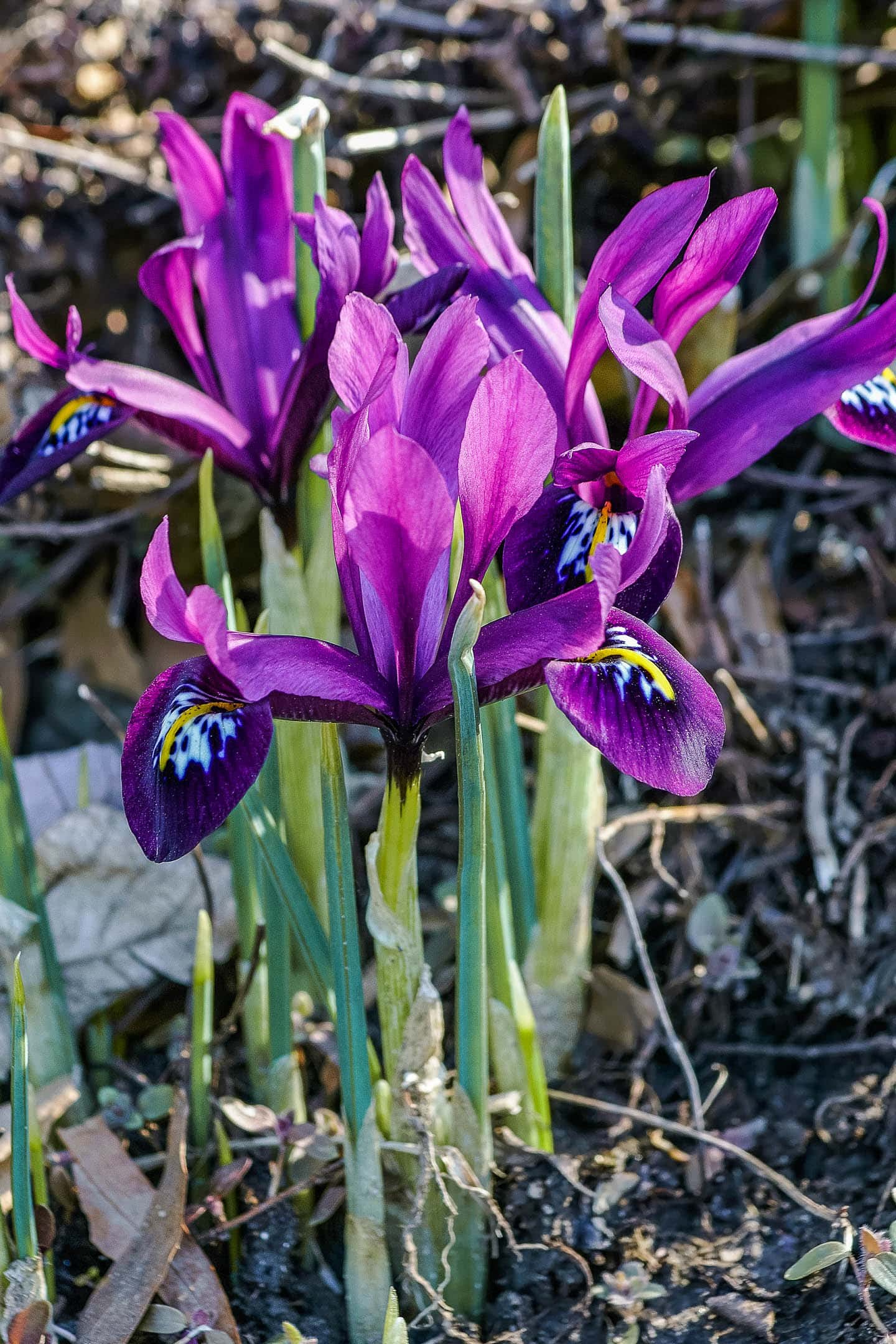
Zone: 3 to 8
Exposure: sun with afternoon shade
Height: 6″
Width: about 4″
Bloom time: early spring
Bloom color: plum-purple with a little yellow
George is a true purple mini iris that is easy to grow in well drained humous-rich soil.
The flower and stock are slightly larger than the more common blue Iris reticulata varieties.
It looks lovely in rock gardens or perennial beds. And it is deer resistant.
Plant about 6 bulbs per square foot, 2″ to 4″ deep and cover with 2″ of mulch.
3 | Muscari
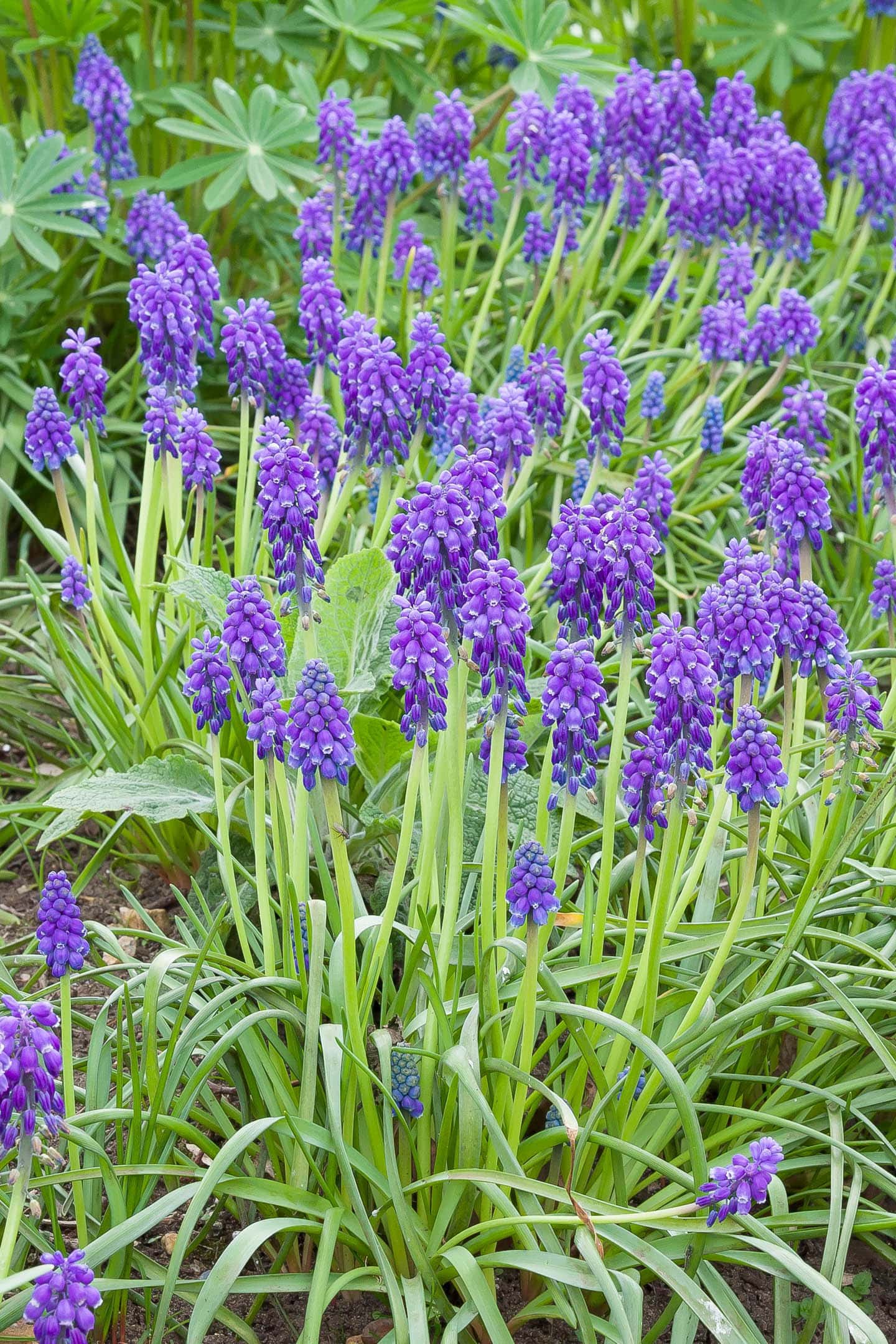
Zone: 5 to 8
Exposure: sun, part shade
Height: 4″ to 8″
Width: 3″ to 4″
Bloom time: early spring
Bloom color: vibrant purple, blue, pink, white
Muscari is another bulb with early blooming purple flowers that have a beautiful perfume.
Because it is fairly small, they look best in mass plantings. And will naturalize over the years.
It is also a deer-resistant bulb.
Purple varieties:
- ‘Grape ice' – white to wine purple ombre flowers. Buy it HERE.
- ‘Blue grape' – vibrant purple flowers. Buy it HERE.*
- ‘Feather hyacinth' – feathered plum flowers. Buy it HERE.*
4 | Pasque Flower (Pulsatilla Vulgaris)
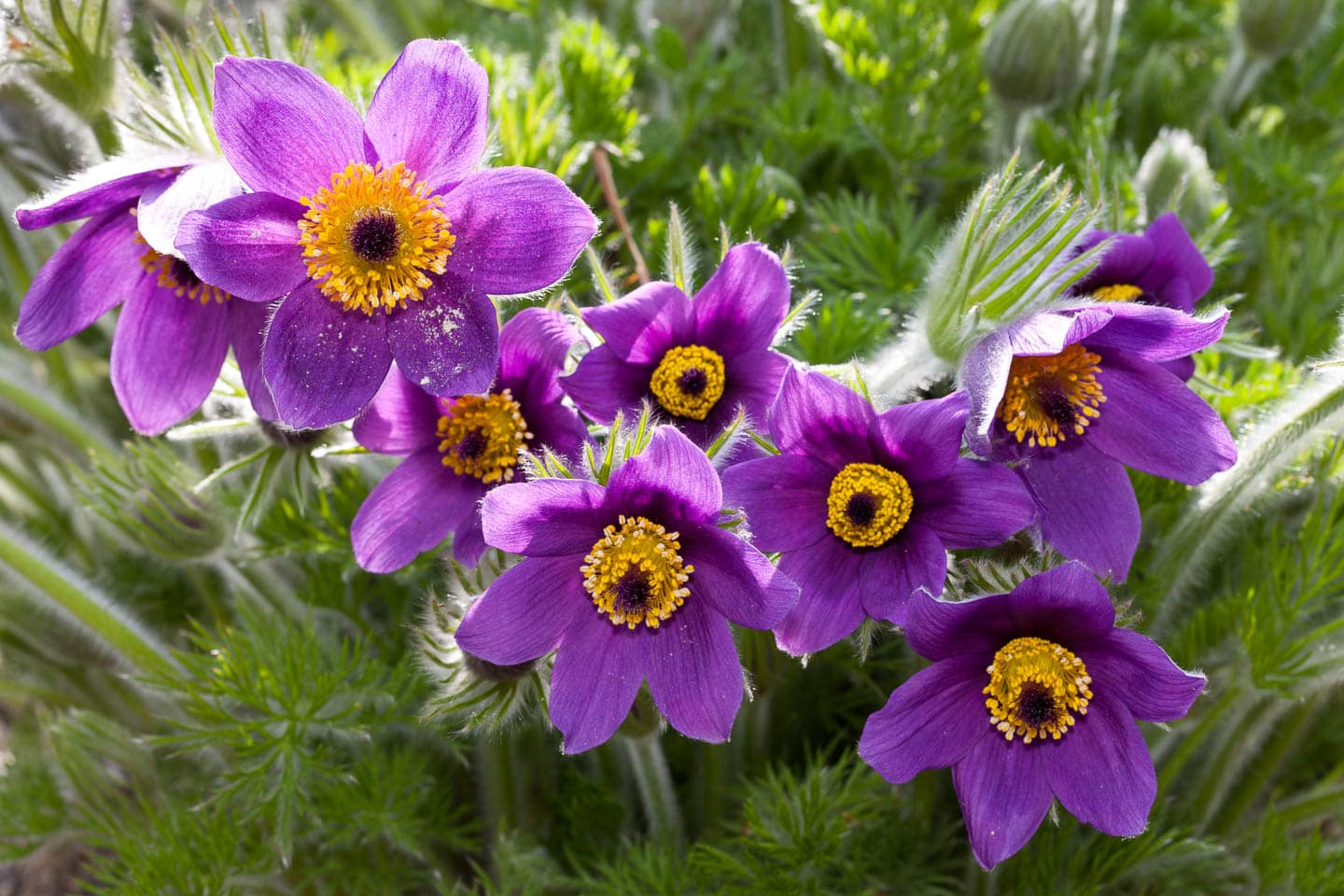
Zone: 4 to 7
Exposure: Sun
Height: 6″
Width: 4″ to 8″
Bloom time: early spring
Bloom color: deep, rich purple is the most common color. But it also comes in red, white, and pink.
Pulsatilla vulgaris is an early spring purple perennial that is native to meadows in Europe and North America, and grows well in full sun.
Large purple flowerheads with yellow centers nod above deeply dissected silvery fern-like foliage which dies back in the fall.
The deep root system makes the plants hard to transplant, so leave the in situ. Their delicate appearance belies their toughness and drought tolerance.
Propagated from seed they are not widely available at nurseries.
5 | Perennial Primrose (Primula)
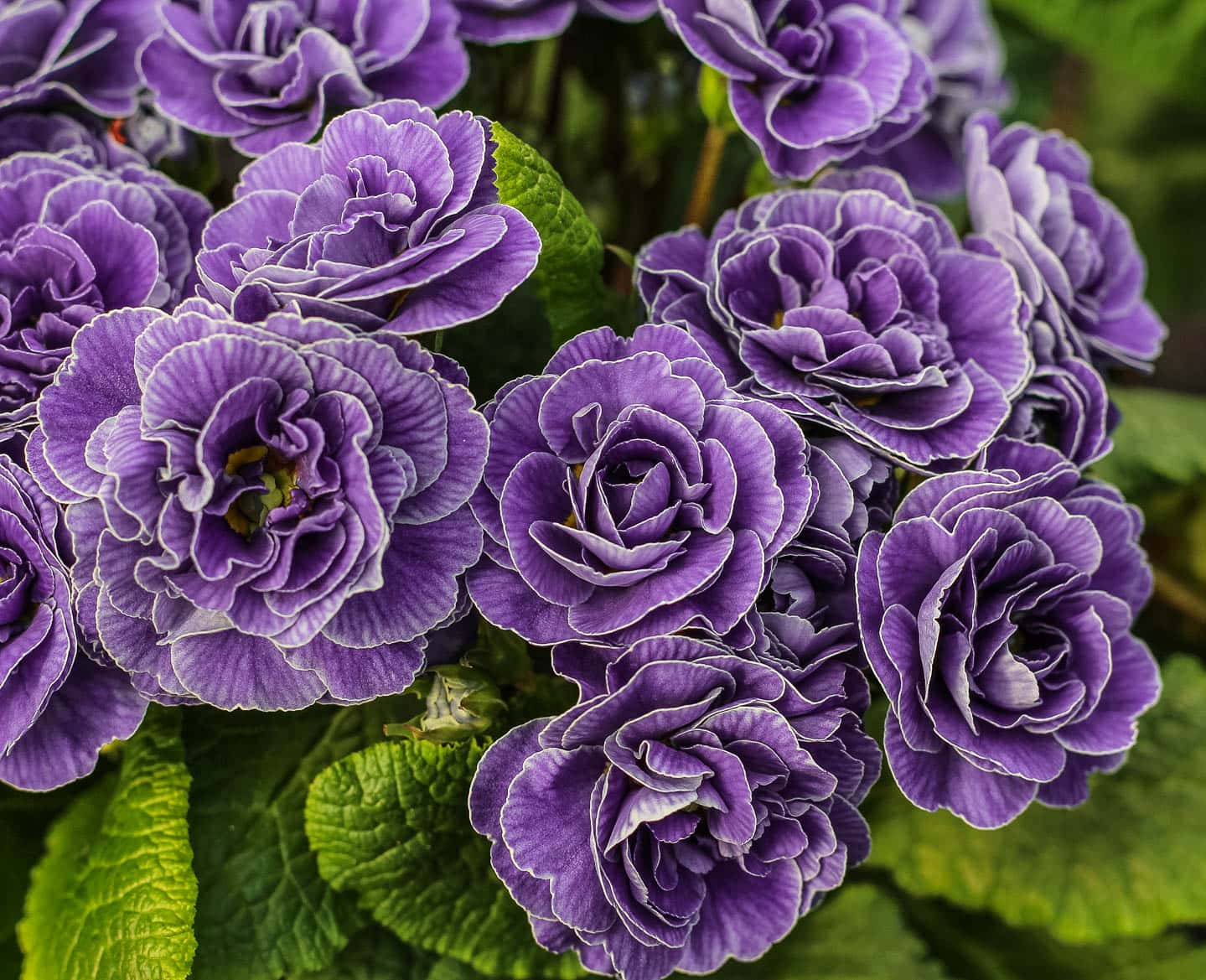
Zone: 3 – 8
Exposure: sun to shade
Height: 2″ to 8″
Width: 10′ to 1′
Bloom time: early spring to mid spring
Bloom color: purple, yellow, red, pink, blue, or white
There are many varieties of early blooming perennial primulas that produce a profusion of purple hued flowers.
Some are double, almost rose-shaped blooms, while others are more bell-shaped.
They are all easy care perennials that should be planted about 10″ apart in humous rich soil where they will get some afternoon shade.
Primroses tend to repel deer and rabbits.
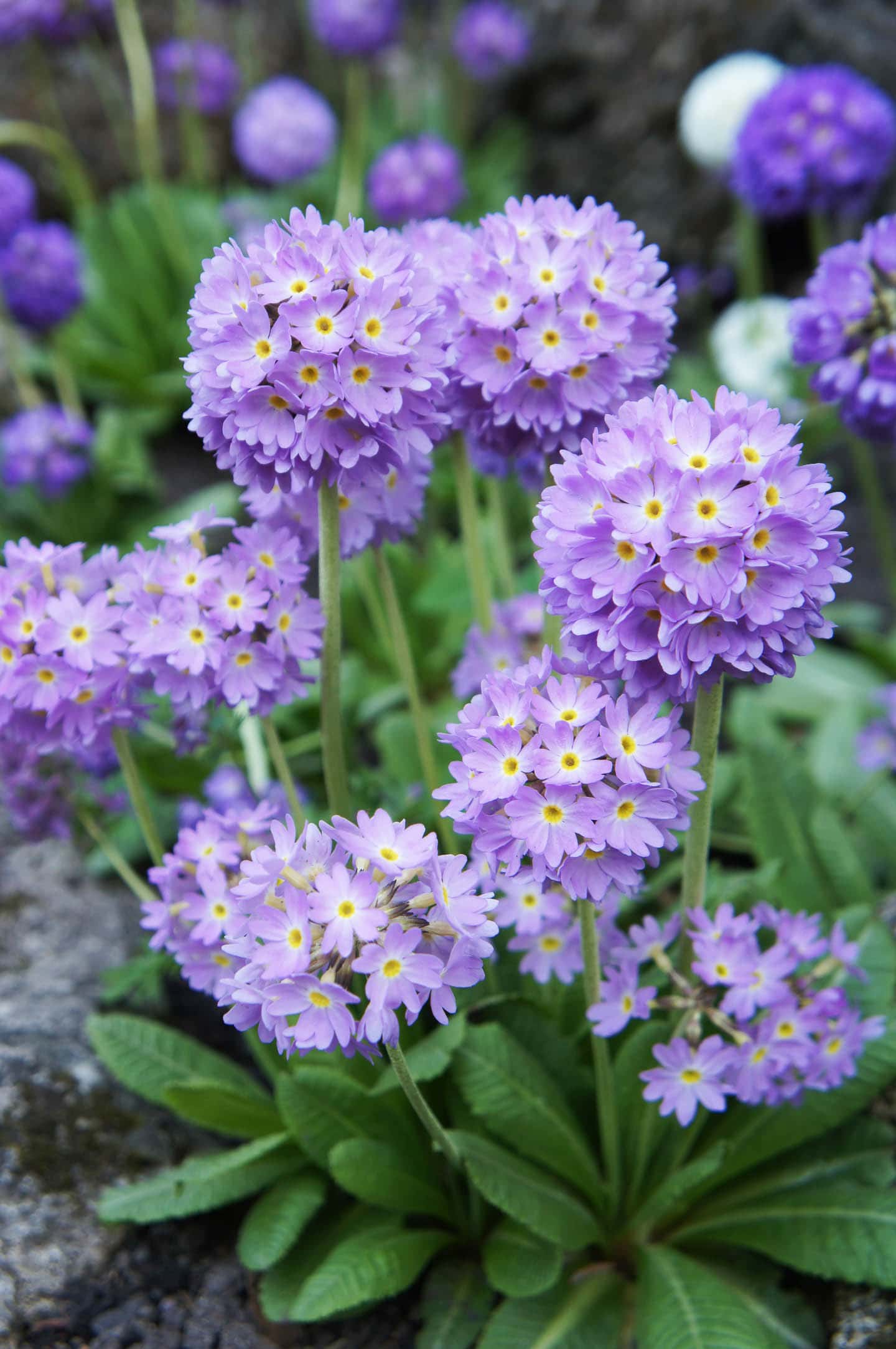
Purple varieties:
- ‘Belarina® Amethyst Ice' – an amazingly tough, outstandingly beautiful, fragrant purple/blue double semi-evergreen eye catching plant for the front of the border or containers. Buy it HERE.
- ‘Belarina® Lively Lilac' – masses of vibrant purple fully-double flowers with white and yellow eyes and ruffled edges. Buy it HERE.
- P. denticulata or drumstick primula — 4″ globe clusters of flowers grow almost a foot high and look magnificent when planted en masse. Tolerates moist soil. An RHS award of garden merit winner. Find it HERE.*
6 | Lungwort (Pulmonaria)
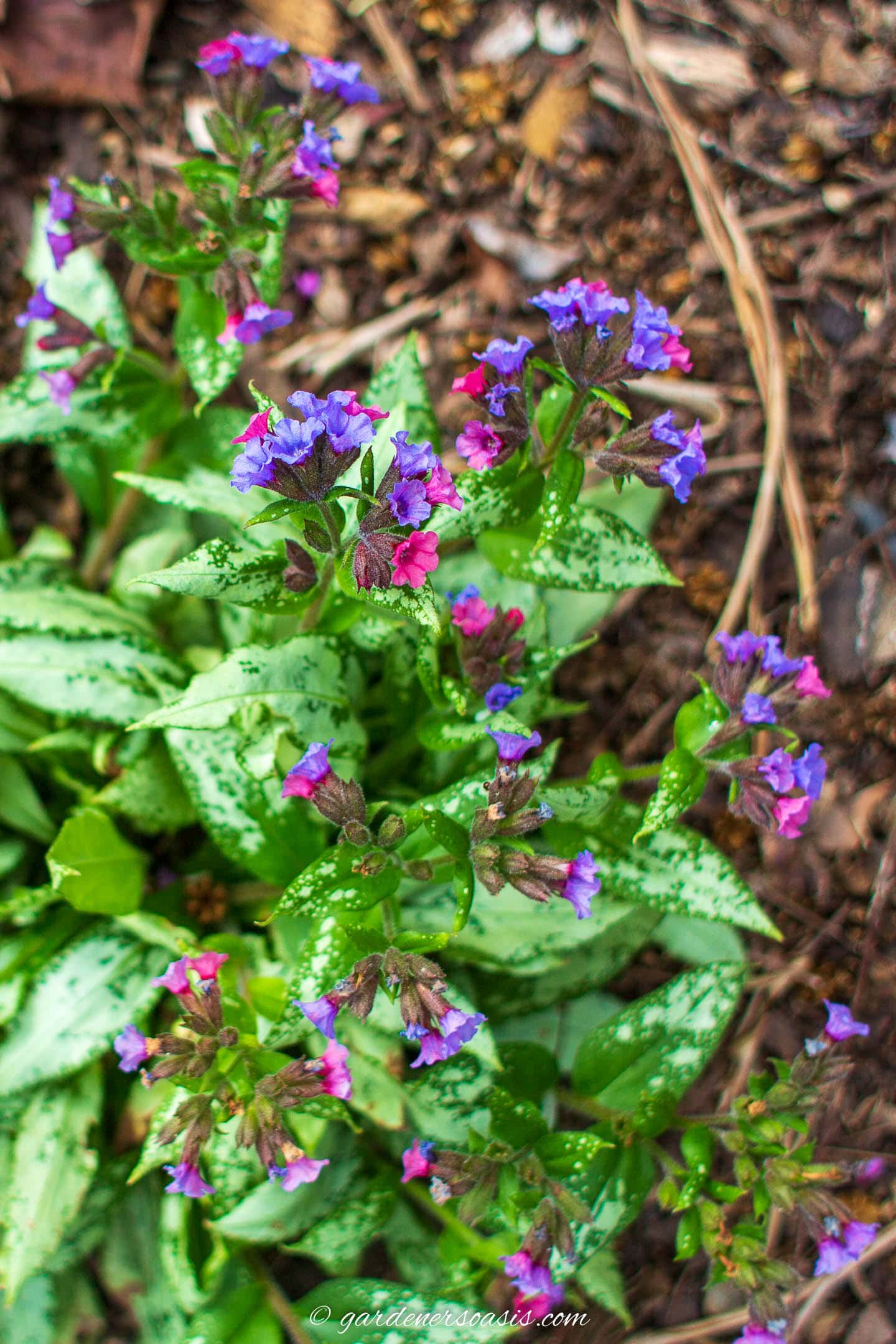
Zone: 3 to 9
Exposure: Part shade, shade
Height: 12″ to 18″
Width: 12″ to 24″
Bloom time: early to late spring
Bloom color: purple, pink, blue
Pulmonaria is another easy-to-grow perennial that thrives in the shade and produces blooms in early spring.
Its clusters of small flowers often start out pink and turn to either a blue or purple color as they age.
Most varieties have interesting leaves that are mottled with silver, and can brighten up the shady areas of your garden even when they aren't blooming.
The plants are mounded in form, evergreen in many zones and dense enough to be used as a ground cover.
7 | Horned Violets (Viola cornuta)
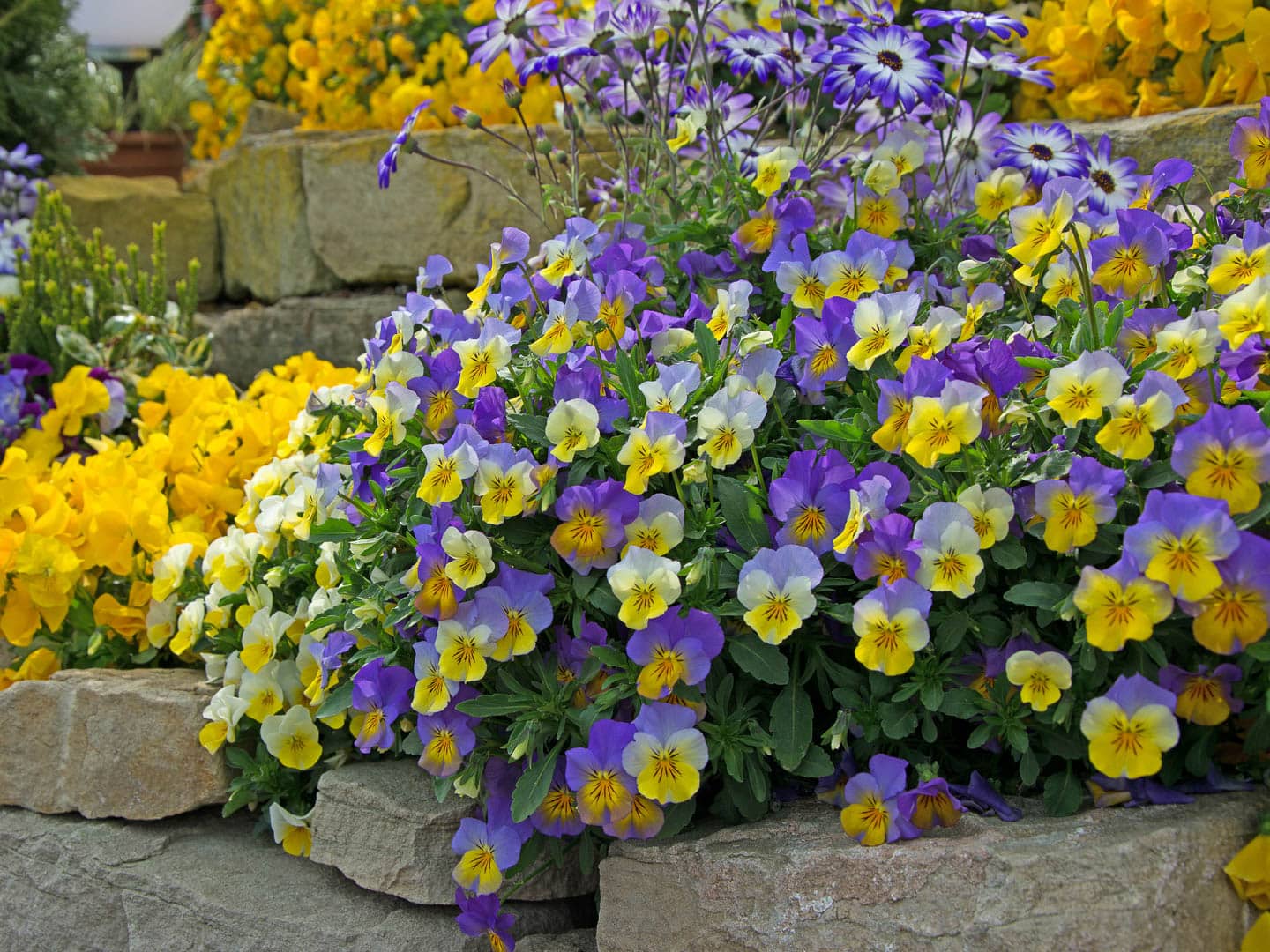
Zone: 5 to 9
Exposure: Sun, part sun
Height: 6″
Width: 4″
Bloom time: early spring to fall
Bloom color: purple-blue with yellow center
These Violas are a perennial plant that have light or dark purple pansy-like flowers with yellow centers and heart-shaped green leaves.
Its low-mounding form looks great at the front of the border and other places in your garden where it can naturalize.
Dead-head the plants to prolong flowering and water regularly, especially in the heat.
Check the bloom time, since some may flower later in the season.
Purple varieties:
- ‘Halo Violet' – dark purple with bright yellow center. Buy it HERE.
- ‘Halo Sky Blue' – periwinkle purple with bright yellow centers. Buy it HERE.
- ‘Northern Lights' – vibrant purple flowers with yellow and orange centers. Buy it HERE.
8 | Sweet violet (Viola odorata)
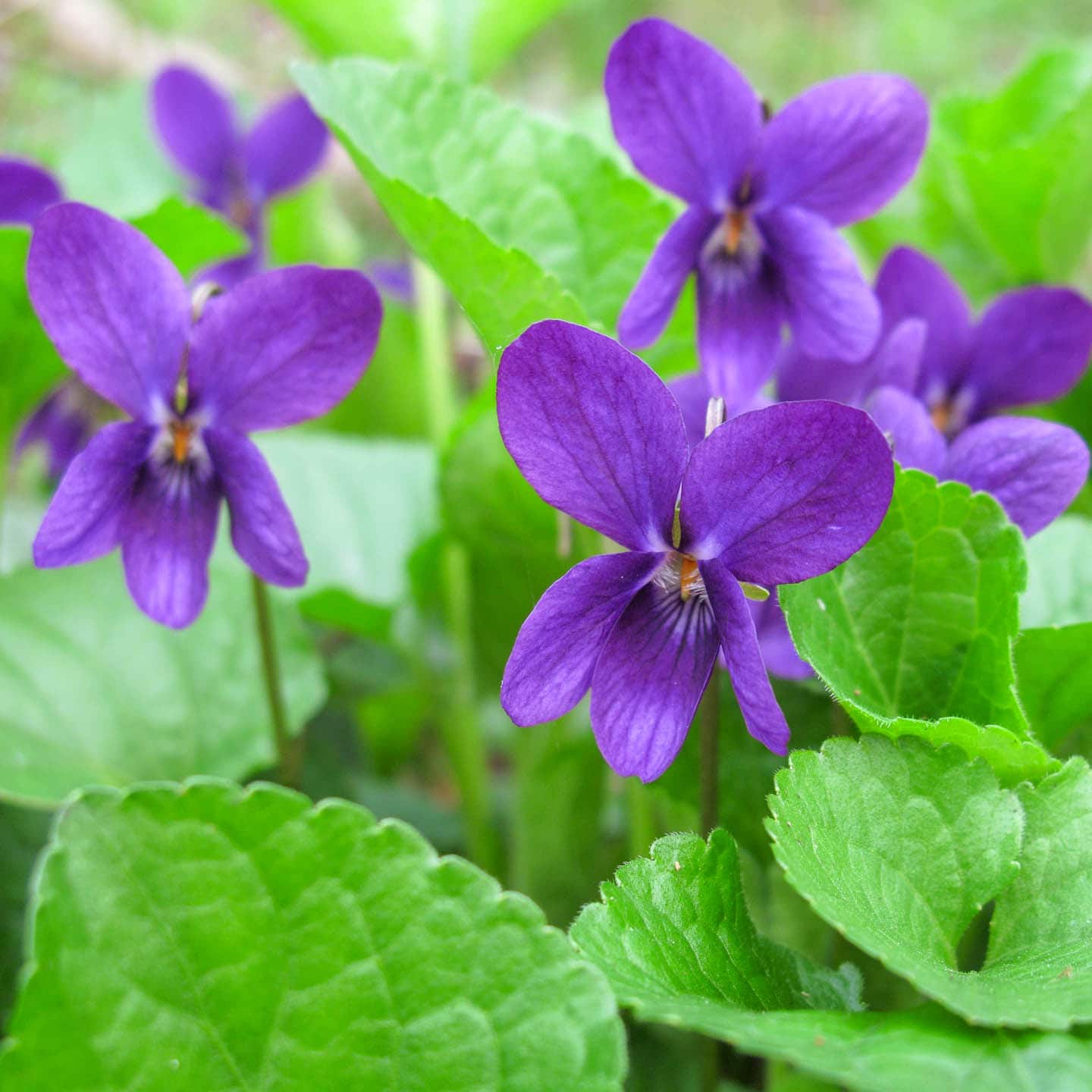
Zone: 4 to 8
Exposure: Sun to shade
Height: 6″
Width: 4″
Bloom time: early spring to fall
Bloom color: purple, white, blue
As the name suggests, Viola odorata has scented purple flowers that bloom above heart-shaped leaves in the early spring.
To prevent them from getting too tall and spindly, pinch the plants back before they bloom.
Then cut them back after they have finished blooming to prevent prolific self-seeding.
These plants grow natively in woodland areas so they prefer evenly moist soil with lots of compost.
Check the bloom time of the variety you buy since some will flower later in the season.
Early blooming purple varieties:
- ‘Queen Charlotte' – deep purple flowers with dark green leaves that grows well under shrubs. Buy it HERE.
9 | Hellebore (Lenten rose)
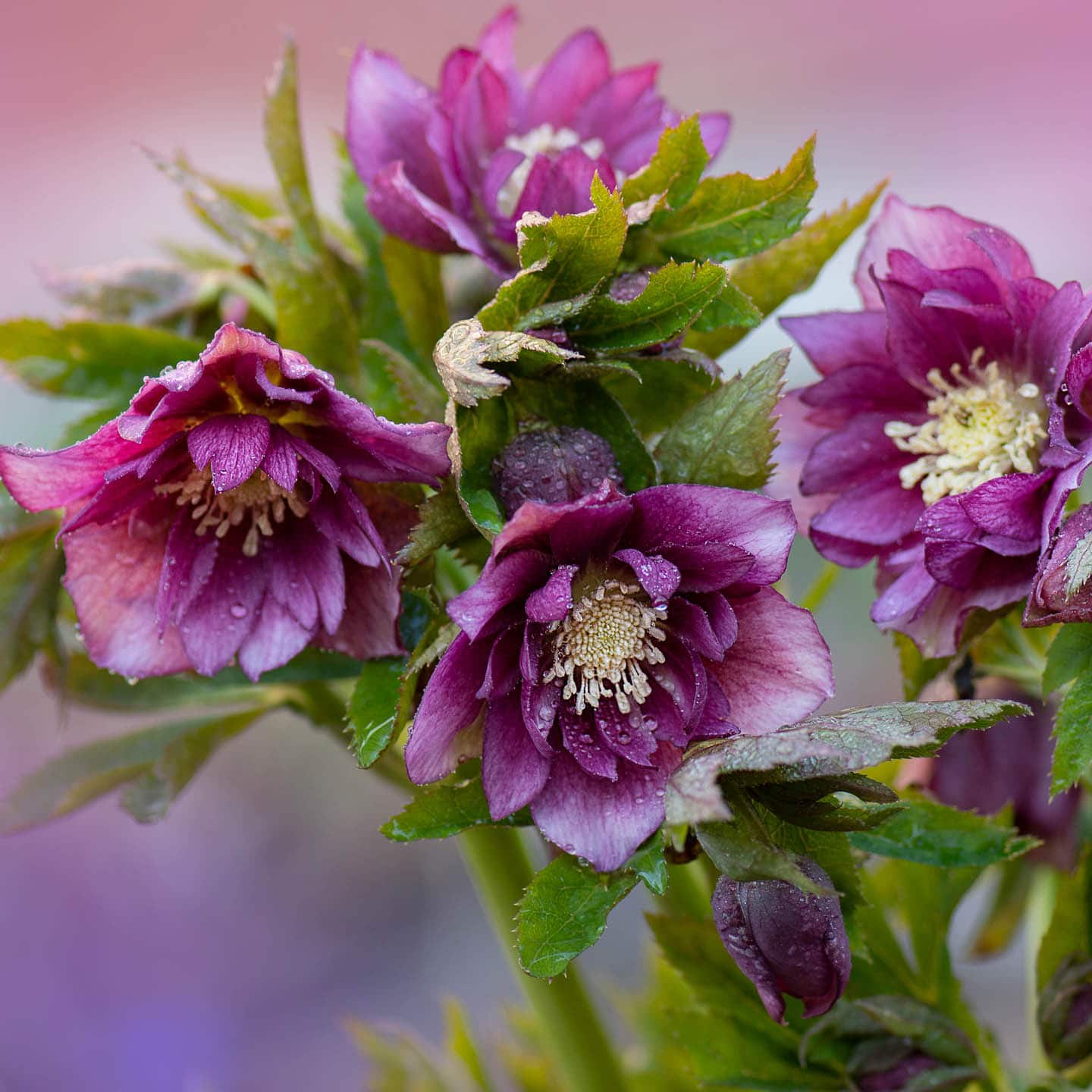
Zone: 4 to 9
Exposure: shade, part shade
Height: 10″ to 12″
Width: 12″ to 14″
Bloom time: late winter, early spring
Bloom color: white to black and many combinations of pink and purple.
Hellebores get their common name (‘Lenten Rose') because they bloom during the Christian time of lent.
They are easy care evergreen plants that flower for weeks in very early spring, to bring fun and joy to the shade garden at that bleakest of gardening times.
Hellebores like consistently moist soil and do not like to be moved once established.
Some gardeners trim the old leaves to the ground in late winter to better showcase the blooms. (I only remove the dead leaves).
Lenten Rose are toxic which helps them to repel deer and rabbits. But you should also wear gloves when handling them to prevent skin irritation.
Purple varieties:
- ‘Winter Plum' – wine-colored double flowers with golden centers. Buy it HERE.*
- ‘Double Ellen Purple' – a new introduction with double flowers, lightly speckled on the outer petals and a spider-like creamy center. Buy it HERE.*
10 | Creeping Phlox (Phlox Subulata)
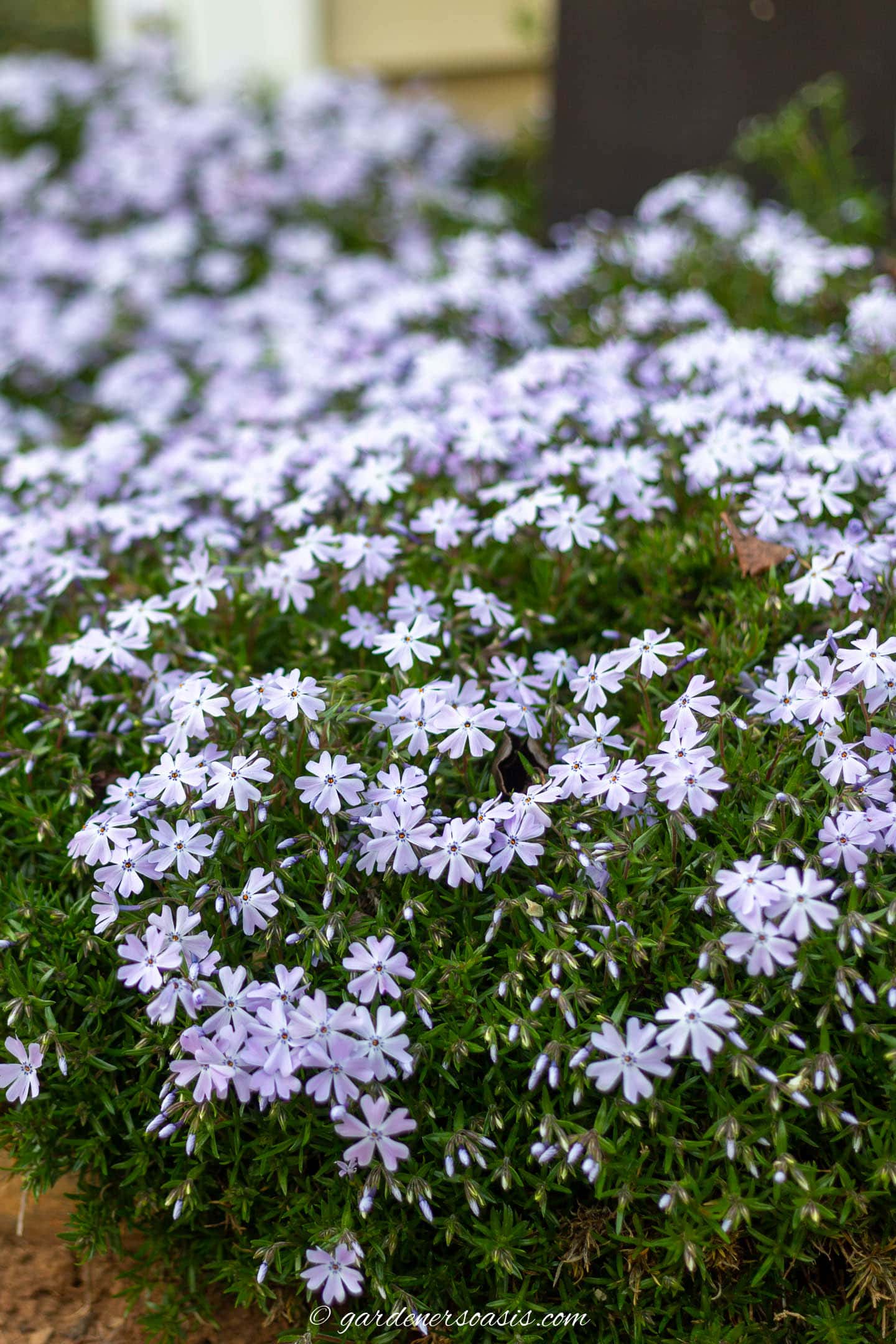
Zone: 2 to 9
Exposure: Sun
Height: 4″ to 6″
Width: 6″ to 12″
Bloom time: early spring
Bloom color: lavender purple flowers with deep violet eyes
Phlox subulata has masses of small lilac flowers that cover a bed of dark evergreen needle-like foliage in a big show in early spring.
It is tolerant of rocky and dry soils, and thrives in full sun.
Which makes it a particularly effective ground cover on slopes and border edges where it will drape over the edges of walls and bloom for 3 to 4 weeks.
If necessary, you can shear creeping phlox back after it has finished blooming to tidy the plant.
Purple varieties:
Although the name suggests that ‘Purple Beauty' would be the best purple variety, it looks more like pink to me. I find that ‘Emerald Blue' is actually more of a lilac color (as you can see in the picture above). Buy it HERE.*
11 | Pansy
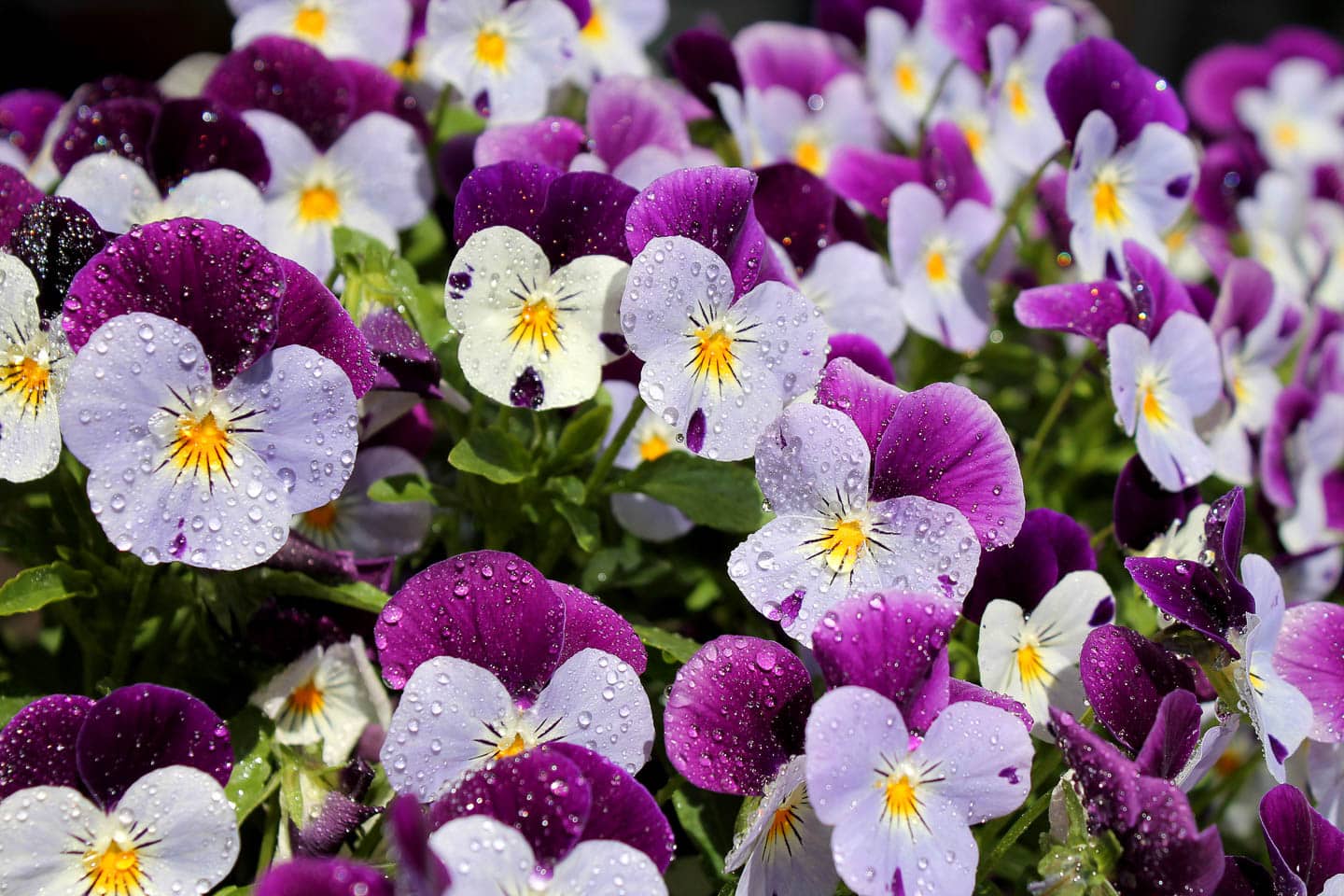
Zone: does well in all zones when the temperature is cool (from 40 deg. F to 60 deg. F)
Exposure: Sun, part sun
Height: 6″ to 9″
Width: 6″
Bloom time: early spring except in the south where it will bloom from fall through winter and spring
Bloom color: blue, lavender, purple, red, orange, bronze, yellow, and white.
Pansies are annuals that are hybrids of the native viola plant but with larger blooms.
They make very cheerful container plants or mass plantings in flower beds.
Deadhead the plants to keep them tidy and prolong bloom. And for the best blooms, keep them well watered but not soggy.
When they become leggy in the summer heat, replace pansies with more heat tolerant annuals.
You can find these plants at most garden centers.
12 | Annual Primrose (Primula Acaulis)
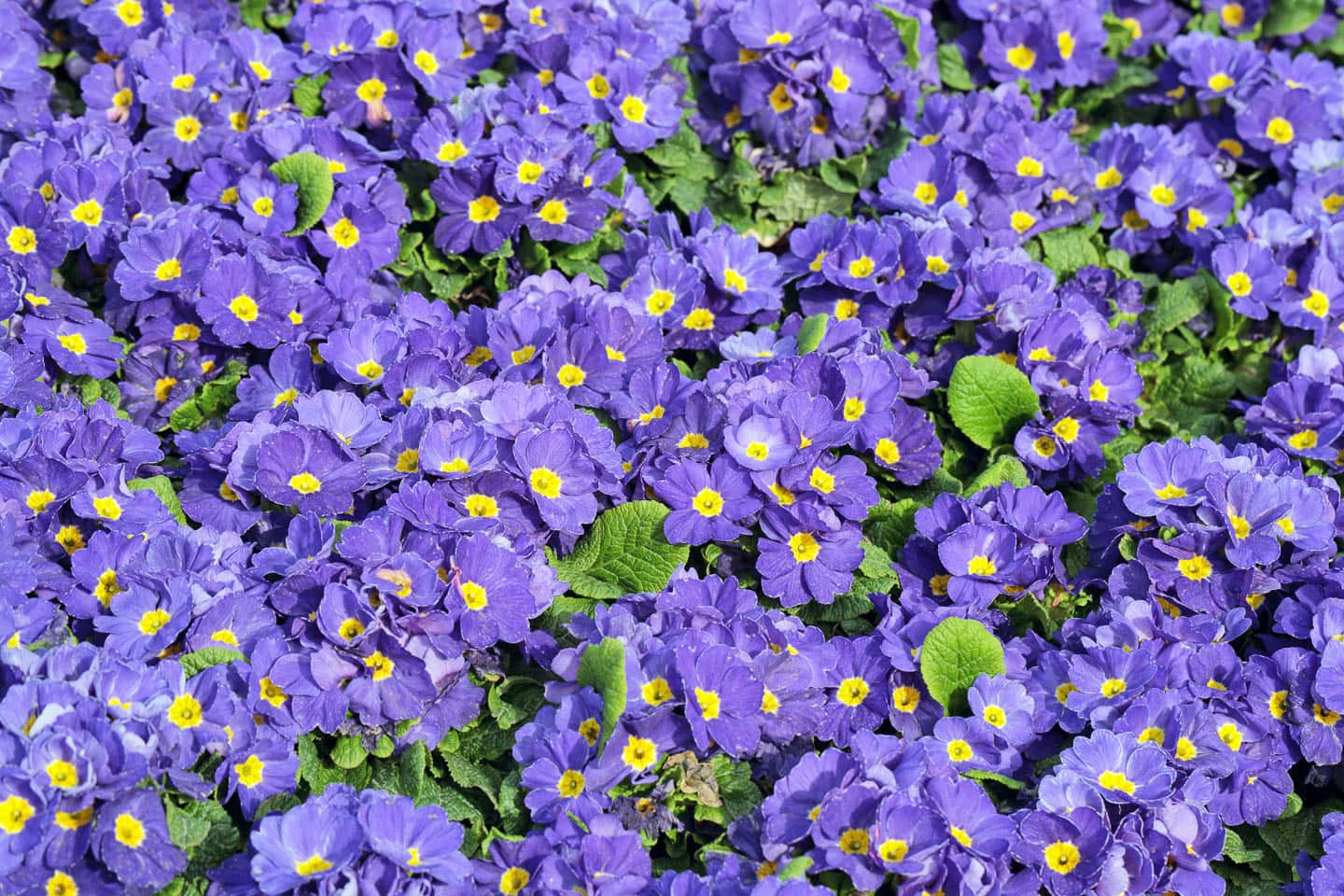
Zone: 4 to 8 annual
Exposure: part shade, sun
Height: 5″ to 6″
Width: 5″ to 7″
Bloom time: winter, early spring
Bloom color: purple, yellow, white, red, pink. Many have yellow centers.
There are many annual primroses that have early spring purple flowers.
Primulas work well in planters either solo or mixed with other early bloomers like iris and daffodils. They can also be used as a bedding plant.
Primroses are also deer resistant.
Purple varieties:
One of my favorites is ‘Primlet Purple'. It is the most vigorous in the primlet series and tolerates light frost. Grow it from seeds, found HERE*.
Well that's it for our list of early spring purple flowers. Hopefully, you've found some ideas to add to your plant list!
Other early spring gardening ideas you might like
- Early spring blue flowers
- Early spring yellow flowers
- How to get your garden ready for spring
- The earliest spring flowers
- The best companion plants for bulbs in the shade
Have comments or questions about our early spring purple flowers? Tell us in the section below.
This post was originally published on March 11, 2022 but was updated with new content on November 23, 2024.

